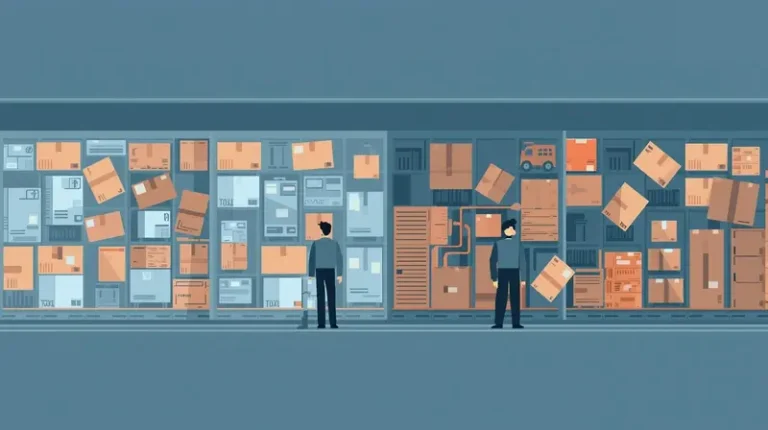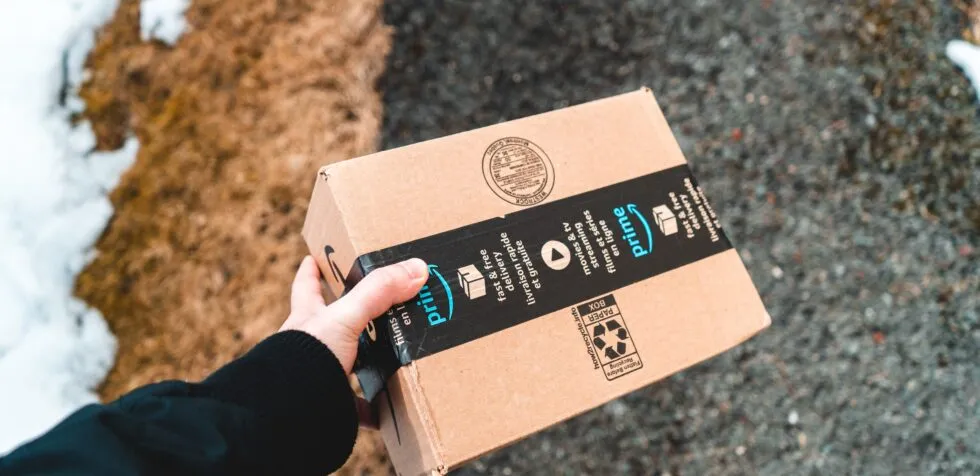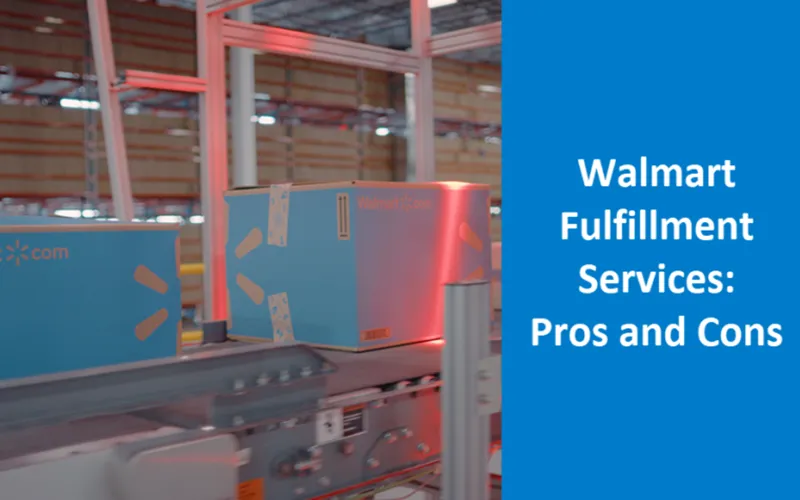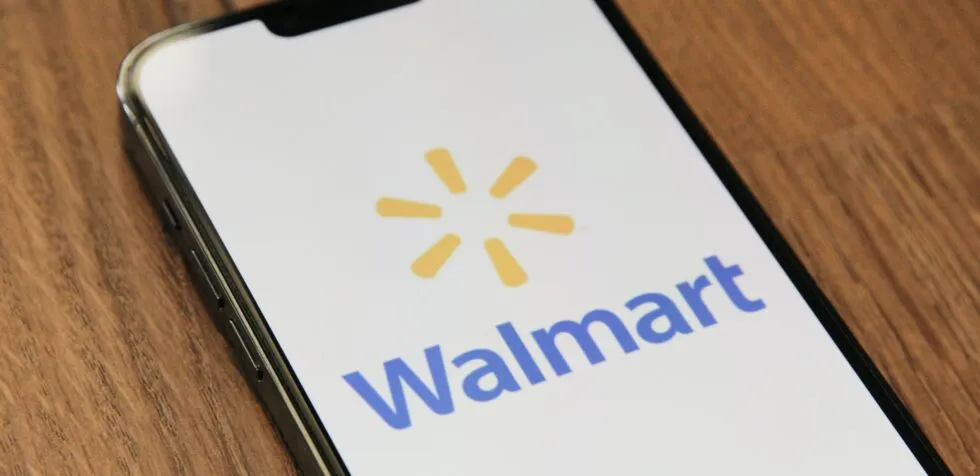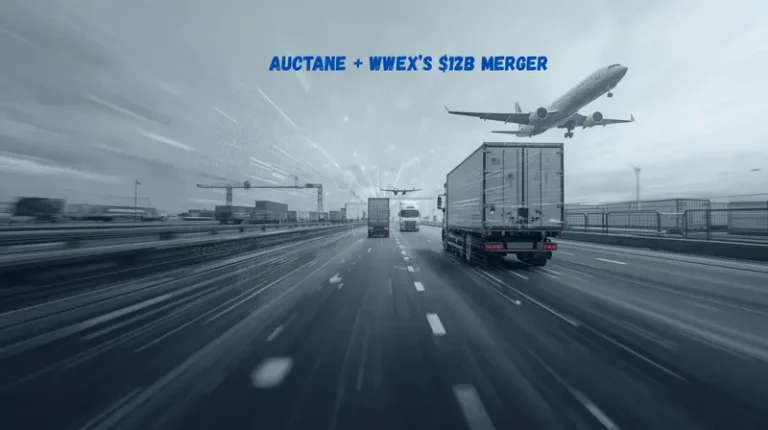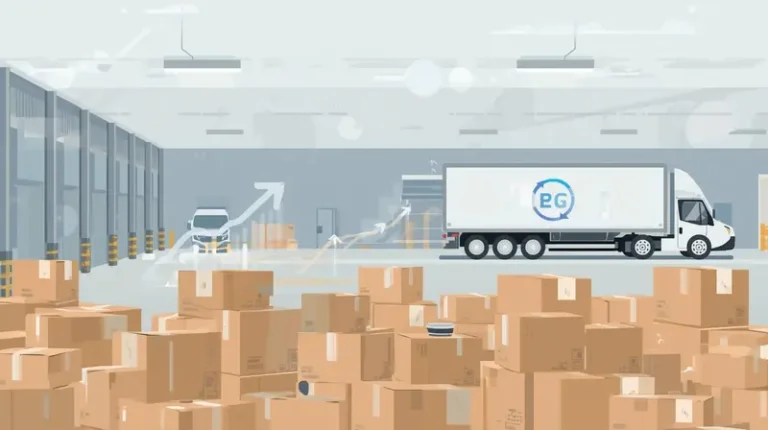Top 3 Alternatives to Amazon FBA
What’s not to love about Amazon FBA? List your product on Amazon, send them your inventory, and reap the rewards of the Amazon Prime badge and low shipping costs (though FBA fees are rising again).
It can be a great deal for small and light products, but sellers need to be aware of rising FBA fees, and that it’s limited in two key ways: 1) it’s an inflexible point solution, and 2) Amazon frequently changes the rules, mostly to its benefit. Also, Red Stag Fulfillment reports that Amazon adds over 500 new 3rd-party sellers a day in 2025, so FBA often struggles to keep up with demand on both the receiving and fulfillment side of the logistics operation. Amazon’s response is to limit FBA to work well only for the SKUs that maximize its profit (not the sellers’) and to impose restrictive inventory limits.
Sellers that want to grow both in and outside of the Amazon marketplace will need an alternative to FBA to keep their growth engine humming. Read on to learn more about what to watch out for with Amazon FBA and your options for other ecommerce order fulfillment solutions.
Why You Can’t Rely on Just Amazon FBA
Amazon FBA will do a great job of fulfilling a portion of the volume of your small SKUs sold on Amazon, but it falls short otherwise.
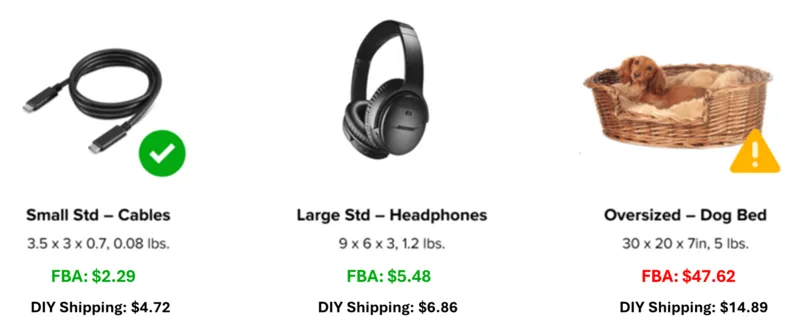
Source: Amazon FBA Revenue Calculator, DIY Shipping estimated using Cahoot discounted shipping rates for Zone 4 Residential addresses.
The above example is typical of Amazon FBA fees: their price for small and standard items beats other options, but even slightly oversized products like the example 5lb dog bed ends up costing more than triple the price that a merchant could ship on their own (or using outsourced fulfillment services). The reason is simple: they’ve optimized their network for small, easy, and efficient products.
As a result, Amazon sellers who use FBA for their shipping are boxed in when it comes to growth, and they all compete with one another to sell the same small, cheaper items. If FBA is your only good option, you can’t profitably expand your product line to larger, less competitive options because fulfillment fees will eat up your margins, making a 3PL a necessary consideration. If you raise the price to compensate, then you’ll lose to the savvy merchants who have diversified their fulfillment strategies and can get the product to the customer at one-third the price.
The challenges don’t end there for Amazon FBA. Ecommerce’s year-over-year unprecedented boom in growth through the pandemic has delivered massive returns to Amazon and Amazon sellers, but it’s also left FBA bursting at the seams. To compensate, Amazon switched from ASIN-level inventory limits to product-type inventory limits, and overnight sellers saw their inventory limits cut by up to 65%. To this day, Amazon still enforces restock limits based on broader storage types rather than individual SKUs (e.g., standard-size, oversized, apparel, footwear), applied at the account level rather than per-product. These remain the primary structure for restock limits in 2025.
However, recent trends indicate that Amazon has quietly reinstated some ASIN-level restock restrictions on top of storage-type limits, especially during periods of high demand or for seasonal products. These additional thresholds mean that even if your total storage capacity is sufficient, a specific ASIN may be capped based on the seller’s historical sales and forecasted demand. These mixed restrictions are reported to be in effect as of mid-2025.
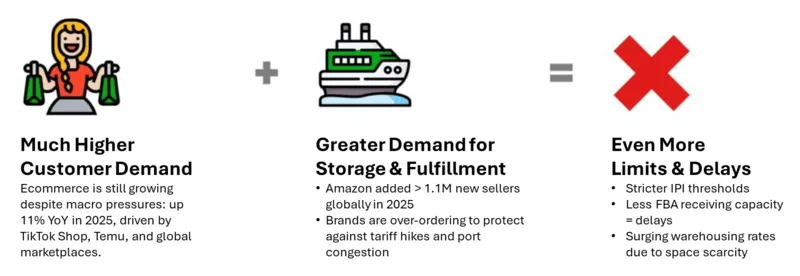
Source: US Census Bureau, Marketplace Pulse, Cahoot interviews with merchants
On top of the storage limitations, Amazon FBA can also take three or more weeks to receive inventory. This creates a huge window of time in which a seller can run out of stock on a key item, even if the seller sent a timely replenishment. And this assumes you chose the more complex and costly inbound plan and shipped all your inventory to regional Amazon FCs (rather than sending it all to one location and paying Amazon to distribute (place) the inventory for you). In the peak selling season, this is an even bigger problem. Demand surges can easily run an item out of stock in a matter of days or even hours, triggering a death spiral in which a product loses its search rank, which lowers impressions and conversions, which in turn lowers inventory limits again.
It’s clear that Amazon FBA is no longer an all-in-one solution for Amazon sellers. It’s a point solution that can be an important part of a fulfillment strategy, but needs to be augmented to cover for its flaws.
Slash Your Fulfillment Costs by Up to 30%
Cut shipping expenses by 30% and boost profit with Cahoot's AI-optimized fulfillment services and modern tech —no overheads and no humans required!
I'm Interested in Saving Time and MoneyEvaluating Amazon FBA Order Fulfillment Alternatives
Amazon FBA’s structure tells a valuable, if simple, lesson: the most cost-effective way to offer nationwide 1-day and 2-day delivery is to create a distributed fulfillment network that always has inventory near the end customer. This setup enables 1- and 2-day delivery with economic ground shipping, and without all the FBA restrictions and limitations; the best of both worlds.
To enjoy the same benefits of Amazon FBA’s network without the same drawbacks, sellers’ options generally fall into three main categories:
1. Open Multiple Fulfillment Centers Yourself
Some merchants consider opening their own network of fulfillment centers, but this path is rarely viable today. Commercial real estate costs remain high, and even when space is available, labor remains unpredictable and expensive. Recruiting, training, and retaining warehouse staff across multiple regions is a full-time operation in itself, often diverting attention from core business growth. Plus, the upfront capital outlay is steep, and long-term flexibility is limited. Consumer demand patterns shift quickly, and you’re locked in if a location becomes unprofitable or underutilized. Managing your own distributed network might seem like a way to “own” your fulfillment, but in practice, it often results in underperformance, overstaffing, and operational drag.
2. Third-Party Logistics Companies (3PLs)
Another option is to outsource fulfillment to multiple 3PLs. These are generally smaller, independent companies not connected to any specific marketplace, but can offer comprehensive supply chain solutions. But, you will have to contract with numerous 3PLs to get nationwide 1-day and 2-day coverage. Order routing across disparate 3PLs is complex and labor-intensive, so you may need to invest in expensive fulfillment software to make it more efficient. Fulfillment costs will vary between 3PLs, and not all of them can meet the strict SLAs needed to win the Buy Box on every marketplace, so be sure to use something like a 3PL request for proposal (RFP) template to get an apples-to-apples comparison.
3. Tech-enabled Fulfillment Network
A modern and affordable alternative to working with 3PLs is to use an ecommerce order fulfillment network. A tech-enabled fulfillment network upgrades the traditional 3PL model to cover the whole country in a single solution. Merchants send their inventory to multiple nodes in the network, and then the network’s software will automatically send parcels from the optimal location to the end customer, saving on shipping costs. In essence, these networks are “FBA-lite” – they have the same core functionality as FBA.
Definition of a Fulfillment Company
A fulfillment company is a third-party logistics (3PL) provider that specializes in managing the entire order fulfillment process for ecommerce businesses. They handle tasks such as inventory management, warehousing, order processing, packaging, and shipping. By outsourcing these logistics services, ecommerce businesses can focus on their core operations, such as marketing and product development, while the fulfillment company ensures that orders are processed efficiently and accurately.
Looking for a New 3PL? Start with this Free RFP Template
Cut weeks off your selection process. Avoid pitfalls. Get the only 3PL RFP checklist built for ecommerce brands, absolutely free.
Get My Free 3PL RFPBenefits of a Fulfillment Company in Ecommerce
A fulfillment company plays a crucial role in providing efficient and cost-effective order fulfillment services to sellers. Acting as an extension of the ecommerce business, these companies manage logistics and supply chain operations, ensuring that customers receive their orders quickly and accurately. This allows ecommerce businesses to scale their operations without the burden of managing warehousing, packing, and shipping, ultimately enhancing customer satisfaction and operational efficiency.
Cahoot: Alternative to Amazon FBA
Cahoot is a robust FBA alternative, and it works just as well as a backup or enhancement to FBA as it does as a full replacement. And Cahoot’s much more than that; it’s the most flexible solution in the marketplace and can ship orders for every ecommerce sales channel.
Cahoot is the next generation of tech-enabled fulfillment networks. Unlike other networks that are collections of 3PLs, Cahoot’s innovative approach unlocks and empowers merchants across the country to fulfill orders for one another. Our peer-to-peer network is a collective of highly vetted ecommerce retailers who offer up excess warehouse space and resources to provide high-quality order fulfillment to other merchants.
As a result, costs are lower than what you get with a traditional 3PL fulfillment company, and service levels are higher. For example, Dunn-Rite Products saves over $100,000 per year in shipping costs alone by shipping local orders from their Indiana and Colorado warehouses, and outsourcing fulfillment to Cahoot for regional distribution (California, Texas, Florida, Pennsylvania). They offer nationwide 1- and 2-day economical ground shipping across all their channels and dominate their category against brands that can’t compete using FBA alone.
So you can see: the Cahoot P2P network makes the Dunn-Rite example the norm for anyone selling items that don’t fit into the “small and light” box. Merchants can use the network solely for outsourced fulfillment, similar to FBA; they can partially outsource fulfillment while maintaining some of their own in-house fulfillment capacity (where it makes sense), and they can even choose to join the network as a fulfillment partner and fulfill orders for other merchants allowing them to offset some of their own outsourced fulfillment costs.
Frequently Asked Questions
What are the costs for FBA?
The main costs associated with Amazon FBA are fulfillment fees, storage fees (including aged inventory surcharges), and any extra charges for removal or disposal of inventory, inventory prep such as barcoding, placement fees, inbound defect fees, and possibly others. Make sure to factor these into your pricing strategy!
What is a 3PL?
A third-party logistics company (3PL) is a service provider that either arranges or handles a variety of supply chain functions for a business. These functions can include brokering, shipping, storing, or packing a company’s freight, as well as supply chain strategy and access to technology.
Is 3PL pricing more transparent?
3PL providers ensure transparent pricing by offering customizable logistics solutions and engaging in contract negotiations, which allows for clear and flexible pricing options. This way, you know exactly what you’re paying for and can budget accordingly.
How can I switch from Amazon FBA to a tech-enabled fulfillment network?
To switch from Amazon FBA to a tech-enabled fulfillment network, start by evaluating your current SKUs and sales channels. Choose a network like Cahoot that offers nationwide 1-day and 2-day delivery, integrates with your sales platforms, and provides a streamlined onboarding process. Make sure to assess storage capacity, order volume compatibility, and return logistics to ensure a smooth transition that doesn’t disrupt your fulfillment operations.
Do FBA alternatives offer better control over inventory and fulfillment costs?
Yes, most alternatives to Amazon FBA give merchants greater control over inventory distribution and fulfillment costs. Unlike FBA, which imposes inventory limits and seasonal surcharges, tech-enabled networks and independent 3PLs allow for dynamic inventory allocation and cost transparency. This flexibility helps sellers reduce storage costs, optimize shipping rates, and avoid stockouts, especially during peak seasons or marketplace fluctuations.

Turn Returns Into New Revenue

eBay Fulfillment: How Fast Shipping Helps You Grow
In this article
 14 minutes
14 minutes
- What is eBay Fulfillment?
- Why is Fast and Free Shipping Important for eBay Fulfillment?
- Overview of Options for eBay Fulfillment Services
- Choosing the Right Fulfillment Service
- International Shipping and eBay Fulfillment
- Inventory Management and eBay Fulfillment
- Why Cahoot Is the Best Option for eBay Fulfillment
- Frequently Asked Questions
Fulfillment is often an afterthought for sellers – after all, “sellers” want to sell. Your eBay fulfillment strategy, though, has a much bigger impact on sales than you might realize. Utilizing an eBay Fulfillment Center, a comprehensive third-party logistics provider, can streamline order processing, manage inventory, and ensure timely deliveries, significantly enhancing customer satisfaction and business performance. If you’re not offering fast and free shipping, you’re severely limiting your growth. And if you don’t have the right provider, you’ll pay an arm and a leg for that shipping, eating up precious profits.
In this article, we’ll highlight the importance of fast and free shipping on eBay (if you’re not already convinced) and give a primer on your different options for eBay fulfillment. By the end, you’ll feel much more confident in your ability to turn operations into a growth driver for your business.
What is eBay Fulfillment?
eBay Fulfillment is a comprehensive service designed to help sellers outsource their order fulfillment processes to a trusted third-party logistics provider. This service allows sellers to focus on growing their business while leaving the logistics and shipping to a reliable partner. eBay Fulfillment centers offer a range of services, including storage, packing, and shipping, ensuring that orders are fulfilled quickly and efficiently. By leveraging an eBay Fulfillment service, sellers can significantly improve customer satisfaction, reduce shipping costs, and increase their overall profitability. With streamlined fulfillment processes, sellers can ensure that their customers receive their orders on time, every time.
Slash Your Fulfillment Costs by Up to 30%
Cut shipping expenses by 30% and boost profit with Cahoot's AI-optimized fulfillment services and modern tech —no overheads and no humans required!
I'm Interested in Saving Time and MoneyWhy is Fast and Free Shipping Important for eBay Fulfillment?
Online Shoppers Want Fast and Free Shipping
Thanks to Amazon Prime, online shoppers now expect their orders to arrive quickly and for free. In fact, a McKinsey study found that over 90% of customers view 2- to 3-day delivery as the baseline for eCommerce. eBay sellers used to be relatively immune from these rising customer expectations, but those days are over.
Ignore fast and free shipping at your own risk – US consumers expect free shipping even on orders under $50, and 48% of all cart abandonment is caused by unexpected shipping costs.
eBay now automatically applies “Free delivery in 2/3/4 days” tags to qualifying products – like the Fast ‘N Free badge that preceded it, this marker gives shoppers exactly what they want. eBay sellers with the tags stand out in search results and convert better, driving higher revenue by leveraging efficient shipping services that enhance order processing and customer satisfaction.
Improve your Seller Rating
Fast and free shipping is a key rating factor that can help to boost your eBay seller rating. Shipping time and shipping fees both have their own line item in “Detailed seller ratings” on eBay, and of course, a high seller rating has a huge impact on eBay sales. Having a reliable fulfillment partner is crucial for effectively managing shipping and logistics, ensuring timely delivery and high service standards.
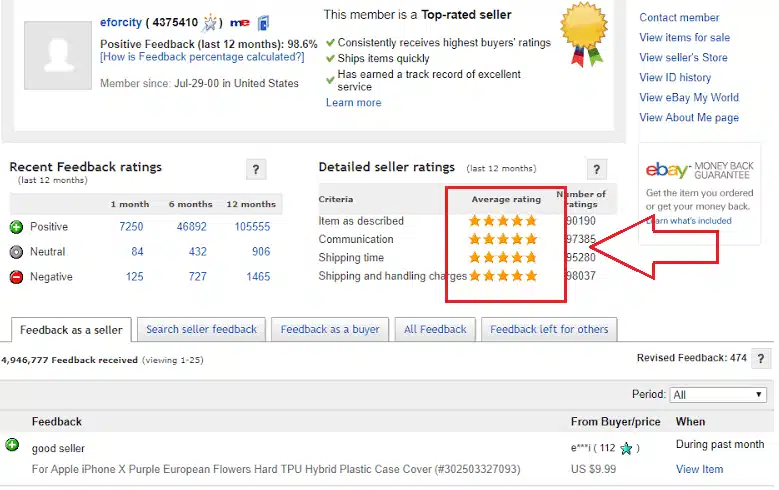
Furthermore, qualification for the lucrative Top Rated Seller Program depends in part on fast shipping – so if you want to be in the top echelon of eBay sellers, you’re going to need fast and free shipping.
Increase Impressions
Free shipping helps you win more impressions and clicks on the eBay marketplace by providing actionable tips for sellers.
eBay gives users the ability to filter by “Free shipping”, meaning that if you’re charging for shipping, some buyers are completely excluding you from consideration. Even if they don’t filter out “Free shipping”, many others will sort their search results by “Price + Shipping” – that’s right; eBay’s price sort includes the cost of shipping, so if you undercut your competitor on product price, but have a shipping fee, you’ll still lose out.
On top of that, eBay prominently writes “Free shipping” for products that don’t charge for shipping, making them stand out against others that come with hefty shipping fees.
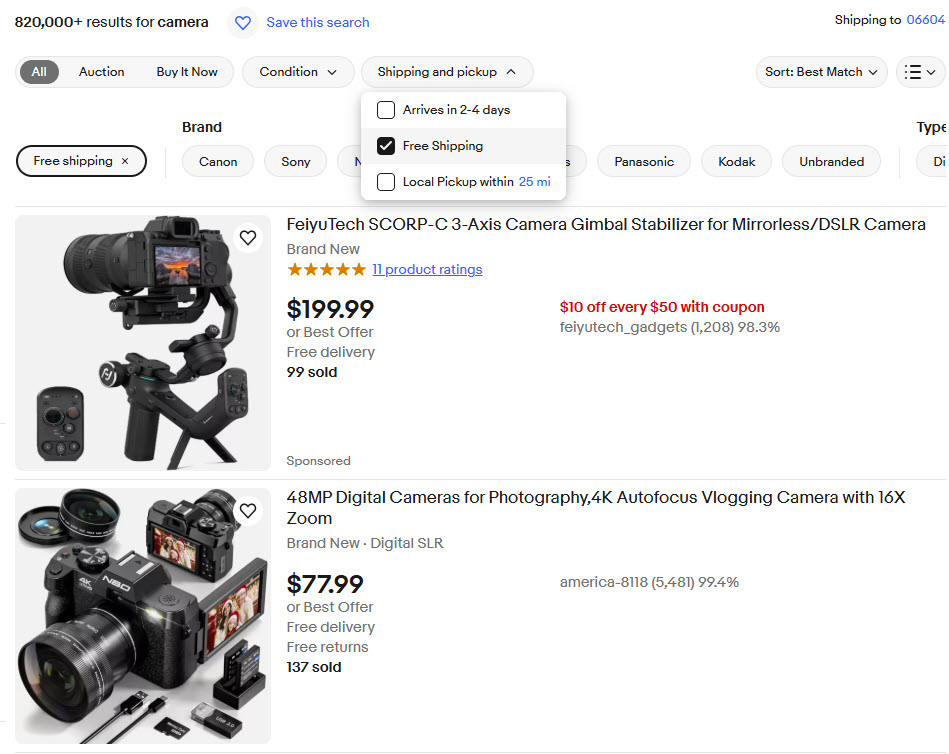
The combination of filters, sorts, and “Free shipping” copy all combine to make it an excellent way to boost your search page results on eBay.
Lower Cart Abandonment and Boost Conversion Rate
The impact of fast and free shipping isn’t limited to the product search experience. In truth, it makes the biggest difference once customers are on the product page itself. Consider that unexpected costs at checkout, including shipping, are the number one cause of abandoned carts, causing 48% of all shoppers to abandon.
Consumer preferences are clear – they convert more often and abandon their shopping cart less frequently when they’re offered free shipping. Effectively managing and fulfilling orders enhances efficiency in eCommerce, ensuring that customers receive their products quickly and reliably.
Improve Customer Lifetime Value
Shoppers will often go the extra mile for free shipping, which opens up creative strategies to boost your repeat purchase and retention rates.
Invesp found that 58% of customers will add items to a cart to qualify for free shipping, 47% will search for an online promo code, and 31% will join a loyalty program.
If you don’t want to offer free shipping right off the bat, then you can introduce an order value minimum or offer free shipping to people that sign up for a loyalty program. Both of these actions will improve your customer lifetime value – bigger carts are self-explanatory, and loyalty program members repeat shop again and again. An effective fulfillment strategy is essential for operating a profitable business, ensuring customer satisfaction and efficiency.
Looking for a New 3PL? Start with this Free RFP Template
Cut weeks off your selection process. Avoid pitfalls. Get the only 3PL RFP checklist built for ecommerce brands, absolutely free.
Get My Free 3PL RFPOverview of Options for eBay Fulfillment Services
So, you’re convinced – you want to offer fast and free shipping on eBay. But how do you do it without breaking the bank? Here are the pros and cons for the different ways you can fulfill orders.
eBay’s managed delivery service is an efficient logistics solution designed for sellers with high-volume inventory, aiming to provide faster delivery while reducing costs and complexities associated with order fulfillment.
Self fulfillment
eBay allows you to ship your items yourself. With in-house fulfillment, you own the process, the profits, and the risks.
The benefit, of course, is that you have full control over the fulfillment process. You can choose where and how your products are stored, ensuring that they’re in the best condition possible when they get to customers. If there are errors in fulfillment, you have the power to immediately fix issues.
The main drawbacks of self-fulfillment are that it’s extremely time-consuming and it isn’t cost-effective in the long run. If you’re fulfilling your own orders, your success comes with a price – more and more of your time will be consumed by managing operations.
If you’d like to learn more about how to go it alone, here’s a more in-depth look at how to offer free shipping and still make a profit.
Local pickup
This eBay fulfillment option is ideal if you sell large or bulky items. It allows you to arrange pickup with the buyer so you can avoid shipping costs and price your items even cheaper.
You’ll need to provide a ZIP code, at least one electronic payment method (in addition to Pay on pickup), customer service, and generate your Proof of pickup to protect yourself in case of “item not received” disputes.
Of course, local pickup limits your market to your locality or contiguous areas. Sellers with serious growth ambitions will need to combine local pickup with another fulfillment option.
Drop shipping
eBay sellers can also use drop shipping to fulfill orders directly from a wholesale supplier. Under this arrangement, your supplier will deliver orders directly to your customers.
Your supplier handles the entire fulfillment process on your behalf using the buyer information available to them. It’s simple and will dramatically reduce your overhead compared to self fulfillment. However, your customers will still hold you responsible for timely delivery and overall customer satisfaction. If the dropshipper makes a mistake, you’re the one that pays the price.
For quality, you don’t get to inspect the product before it gets to the customer. You have to rely entirely on the dropshipper, and when things go wrong, you’re left on the outside looking in.
Just as importantly, your customers won’t be delighted by fulfillment provided by dropshippers. Since they’re almost always shipping from one location, the delivery won’t be fast for customers across the country – and as we explained above, that’s a critical piece of modern eCommerce. Since they’re often shipping long distances, the shipping is more expensive than it needs to be as well.
If you choose this option, don’t list an item on eBay and then purchase it from another retailer or marketplace that ships directly to your customer. If you do, you’ll face sanctions ranging from listing cancellations to forfeiture of fees paid or payable to your account.
3PL fulfillment
If you’re looking for a fulfillment service that offers the benefits of self-fulfillment without all the hassle, then using a third-party provider is your best bet.
The best 3PLs will give you access to a nationwide network of warehouses and carriers, so shipping products will take less time than if you were going it alone – in most cases within one or two days. Furthermore, if a 3PL places your inventory across the country strategically, you’ll always pay ground rates for shipping, so fast delivery will come at low prices.
Like dropshipping, trusting a third party means giving up some control over your product before it gets to the customer. This challenge can become apparent with 3PLs that aren’t built for eCommerce, as products get damaged in their rush to fulfill orders. Modern 3PL networks that specialize in eCommerce, though, have very low defect rates and may even improve on your own delivery record. Multi channel fulfillment is also crucial, as it allows integration with multiple sales channels for efficient order management.
This can introduce complexity and increase your handling fees. A 3PL Request for Proposal can help you to weigh your options.
Scale Faster with the World’s First Peer-to-Peer Fulfillment Network
Tap into a nationwide network of high-performance partner warehouses — expand capacity, cut shipping costs, and reach customers 1–2 days faster.
Explore Fulfillment NetworkChoosing the Right Fulfillment Service
Choosing the right fulfillment service is crucial for eBay sellers who want to ensure that their orders are fulfilled efficiently and effectively. When selecting a fulfillment service, sellers should consider several key factors. First, evaluate the service’s reputation and reliability to ensure that it can consistently meet your fulfillment needs. Cost is another important consideration; look for a service that offers competitive pricing without compromising on quality. Additionally, seek out a fulfillment service that provides real-time inventory management, automated order tracking, and flexible shipping options. It’s also essential to consider the service’s ability to handle international shipping and its integration with the eBay platform. By choosing the right fulfillment service, sellers can enhance customer satisfaction, reduce shipping costs, and boost their overall profitability.
International Shipping and eBay Fulfillment
International shipping is a critical aspect of eBay fulfillment, as many sellers cater to customers around the globe. When choosing a fulfillment service, it’s important to find a provider that offers reliable and cost-effective international shipping options. A good fulfillment service should be capable of handling customs clearance, duties, and taxes, while also providing tracking and insurance options for international shipments. Additionally, the service should offer real-time updates on the status of international shipments, allowing sellers to keep their customers informed every step of the way. By using a fulfillment service that excels in international shipping, sellers can expand their customer base and increase their sales, all while ensuring a smooth and reliable delivery experience.
Inventory Management and eBay Fulfillment
Effective inventory management is a cornerstone of successful eBay fulfillment, ensuring that sellers have the right products in stock to meet customer demand. A top-notch fulfillment service should offer real-time inventory management, allowing sellers to track their stock levels accurately and avoid issues like overselling or underselling. The service should also provide automated alerts when stock levels are low, enabling sellers to replenish their inventory promptly. Additionally, a good fulfillment service will handle inventory storage, receiving, and picking, freeing up sellers to focus on growing their business. By utilizing a fulfillment service with robust inventory management capabilities, sellers can enhance customer satisfaction and reduce shipping costs, ultimately driving their business’s success.
Why Cahoot Is the Best Option for eBay Fulfillment
Cahoot’s eBay fulfillment service will power affordable fast and free shipping for your listings, increasing revenue and margin. Our best-in-class fulfillment network partners with eBay sellers to make fulfillment a breeze – we can get you up-and-running with an improved delivery experience in as little time as it takes you to send us inventory.
With Cahoot, your eBay store can integrate various fulfillment services directly, automating order processing, inventory management, and shipping logistics. Your listings will automatically get eBay 2-day, 3-day, and 4-day fast shipping tags (formerly Fast N’ Free Shipping), boosting conversion.

If you’d like to find out how Cahoot can help your business, please get in touch with us. We can’t wait to show you how fulfillment can power your growth on eBay.
Frequently Asked Questions
What is eBay fulfillment?
eBay Fulfillment refers to eBay’s logistics solutions that help sellers store, pack, and ship their products efficiently. Unlike Amazon’s Fulfillment by Amazon (FBA), eBay does not directly handle fulfillment but partners with third-party logistics providers to offer these services. One of the main programs currently available is eBay Fulfillment by Orange Connex, which provides warehousing, order fulfillment, and fast shipping options for eBay sellers.
Is selling on eBay worth it?
Selling on eBay can be worth it, but it depends on your business model, product type, and goals. eBay offers access to a massive global customer base, and (unlike Amazon) allows for both fixed-price listings and auction-style sales, which can help sellers move inventory quickly or get the best price for rare items. Fees are generally lower than Amazon’s, and there are fewer restrictions on the types of products you can sell.
However, there are challenges. eBay is highly competitive, with many sellers offering similar products, often at low margins. The platform has strict policies on seller performance, and negative feedback can impact sales. If you’re selling high-demand products and can manage fulfillment efficiently, eBay can be a profitable marketplace. However, if you’re looking for a fully automated fulfillment solution like Amazon FBA, eBay may require more hands-on effort.
How much does eBay make on each sale? (eBay fees)
Selling on eBay involves several fees that sellers should be aware of to manage their costs effectively. The primary fees include insertion fees and final value fees.
Insertion Fees: eBay allows sellers to list up to 250 items per month without incurring insertion fees. Beyond this allowance, each additional listing typically costs $0.35. However, certain categories may have different fee structures or exceptions.
Final Value Fees: When an item sells, eBay charges a final value fee, which is a percentage of the total sale amount, including shipping and handling. For most categories, this fee is 13.25% of the sale price up to $7,500 per item, and 2.35% on the portion of the sale over $7,500.
Can I sell on both Amazon and eBay?
Yes, you can sell on both Amazon and eBay at the same time. Many e-commerce sellers choose to list their products on both platforms to expand their reach and maximize sales. However, managing inventory, pricing, and fulfillment across two marketplaces requires strategic planning.
What is the best way to fulfill eBay orders?
The best way to fulfill eBay orders depends on your business size, volume, and resources. Options include self-fulfillment, local pickup, drop shipping, and using a third-party logistics (3PL) provider. Each method has its pros and cons, and the right choice will depend on your specific needs and goals.
How can I improve my eBay seller rating?
Improving your eBay seller rating involves several key factors, including providing fast and free shipping, maintaining accurate listings, offering excellent customer service, and promptly addressing any issues or disputes. Utilizing a reliable fulfillment service can help ensure timely deliveries and enhance customer satisfaction, which in turn can boost your seller rating.
What are the benefits of using a 3PL for eBay fulfillment?
Using a third-party logistics (3PL) provider for eBay fulfillment offers several benefits, including access to a nationwide network of warehouses and carriers, reduced shipping times and costs, and the ability to scale your operations without the need for significant investment in infrastructure. A 3PL can also handle inventory management, order processing, and shipping logistics, allowing you to focus on growing your business.

Turn Returns Into New Revenue

Related Blog Posts
3PL Fulfillment Pricing Comparison: Ecommerce Order Fulfillment: Peer-to-Peer Network vs Traditional 3PL
In the era of online marketplaces, most eCommerce merchants and brands find themselves at the mercy of order fulfillment solutions operated by the powerful corporations who act as gatekeepers for these platforms – for example, Fulfillment By Amazon and Walmart Fulfillment Services. Each platform requires merchants to send inventory to their warehouses and follow their unique policies and requirements. All of them also come with their respective fees and surcharges.
Sellers seeking a better deal have often turned to Third Party Logistics Providers (3PLs). They do so with the ambition of not just regaining control and autonomy over their logistics, but also boosting their profits. Fulfillment companies often adjust their pricing models based on order volume, storage, and shipping factors, which can include volume discounts, providing additional savings to the seller.
The problem, however, is that the vast majority of 3PLs operate from an extremely limited number of locations – hampering the seller from being able to offer customers the free, fast shipping experience that they now expect and demand. To solve this problem, a disruptive, radically different strategy is needed – a peer-to-peer order fulfillment network.
While merchants have worked with traditional 3PLs, a peer-to-peer network is an entirely new idea. Those merchants who have used traditional 3PLs are often unaware of their pros and cons. Far fewer are aware of how they compare to a peer-to-peer network. In this article, we take a deep dive, looking at every factor that influences a seller’s choice of fulfillment partner, and compare traditional 3PLs to peer-to-peer networks on each of them. We highlight how a Peer-to-Peer network can offer significant advantages compared to working with legacy 3PLs.
Cost
Traditional 3PL Fulfillment Services – What Do They Have in Common With Traditional Hotels?
Think of a time when you stayed at a boutique, traditional hotel – are you struggling to find or remember when you last did that? In the era of Airbnb, these single-location hotels have lost significant market share.
Why is that?
The reason is not competition – that there is a segment of travelers looking for a more economical, boutique experience compared to staying at a large hotel chain like Marriott or Hilton. The reason is that these traditional hotels are asset-heavy businesses that have no economies of scale. Because they primarily operate from a single location that they rent or own, they are significantly prone to cost pressures driven by land availability, rental rates, and staffing.
All this has meant that a marketplace model with a vast network, such as Airbnb (almost anyone can rent out a space), offers significant advantages to travelers that traditional hotels cannot hope to match.
What if we told you a traditional 3PL is exactly like these hotels?

A traditional 3PL usually operates from an extremely limited number of locations (2-3 at the most). This provides them with little to no economies of scale. They are also asset-heavy businesses that rent or own their properties. This is compounded by the fact that staff in the warehouse now expect to be paid $19 / hr. With multiple players, such as Walmart and Target, setting up fulfillment centers to deliver their eCommerce orders, traditional 3PLs must pay people more if they are to staff their warehouses. This is also a cost pressure that has to be ultimately absorbed by the merchants who work with them.
Additionally, the surge in e-commerce has significantly increased warehousing costs. The demand for warehouse space and labor has skyrocketed, leading to higher prices and intensified competition within the third-party logistics industry. Traditional 3PLs are particularly affected by these rising warehousing costs, which further strain their ability to offer competitive pricing.
Peer-to-Peer – What do Cahoot and Airbnb Have in Common?
Airbnb’s business model is asset-light – their idea is simple but powerful – anyone that has a spare room at their house that they don’t use can monetize it.
This two-sided marketplace model generates network effects, with millions of customers (property owners and travelers) interacting to ensure the platform offers competitive prices constantly. We have a similar idea for the future of eCommerce – rather than everyone building more warehouses as part of their own private, isolated networks, what if we optimized what’s already available?
Cahoot’s peer-to-peer network aims to unlock the potential of over 2 million retailers with their own warehouses. Any merchant with excess capacity in their warehouses can monetize it by becoming a fulfillment partner for Cahoot.
Our two-sided marketplace model generates network effects, with numerous businesses (sellers and fulfillment partners) interacting to drive prices downward. Just like Airbnb has a massive spread of listings, our model provides us with a vast network of strategically located warehouses across the country. And just like them, we’re more economical than the previous solutions customers used.
Slash Your Fulfillment Costs by Up to 30%
Cut shipping expenses by 30% and boost profit with Cahoot's AI-optimized fulfillment services and modern tech —no overheads and no humans required!
I'm Interested in Saving Time and MoneyQuality
Traditional 3PL – “Fast Shipping or Low Shipping Costs? Pick One”
With the limited number of locations these traditional 3PLs operate from, it becomes near impossible for them to cover the country through economical ground shipping in under two days.
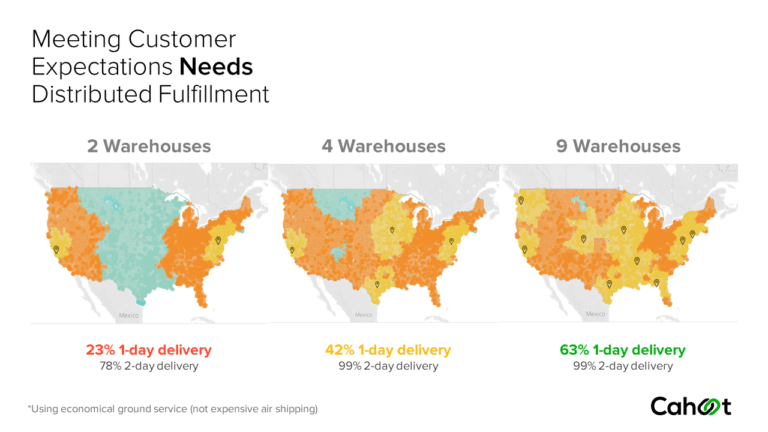
Based on our research, inventory needs to be spread across at least 4 strategic locations if a merchant is aiming for 2-day delivery to the entire contiguous United States (the lower 48 states). If the brand aims for 1-day delivery, it requires nine strategic locations.
When we talk about ‘strategic’ location, we mean it – a location is only strategic if it is located near a major population center. Suppose you’re a brand in the Midwest. In that case, it makes no sense to get excited about saving costs on inbounds by working with a traditional 3PL in Chicago, IL, when most of your orders might be coming from Southern California! Great candidates for strategic locations include New York, Chicago, and Southern California, as examples.
Most traditional 3PLs do not have warehouses at strategic locations – forcing their customers to decide whether to use economic ground services (but not meet the customer expectation for fast delivery) or incur extremely high costs by providing fast delivery through air shipping.
Peer-to-Peer – “Fast Shipping and Low Shipping Costs – Get Them Both.”
A Peer-to-Peer Fulfillment Network has a vast network of strategically located warehouses nationwide. With such a network, it is possible to cover the entire country through ground shipping in under two days. This makes it possible to meet the customer’s expectation for fast shipping while using economical services.
Many sellers might face hefty fees with platform-specific fulfillment services, such as Fulfillment By Amazon (FBA) for Amazon and Walmart Fulfillment Services (WFS) for Walmart. Merchants have no viable alternative because the only way traditional 3PLs can hope to offer the delivery speeds customers are used to is by using expensive air shipping. As no seller is willing to take a margin hit that deep, they are stuck with fulfillment services run by the marketplaces themselves.
With a Peer-to-Peer network, you do not have to make an either-or decision – you get the best of both worlds – providing both your business and your customers with benefits. Our network offers cost savings that boost your bottom line while also improving the experience your customers have.
Service Levels
Traditional 3PLs – Struggle to Offer The Bare Minimum
Traditional 3PLs just about get the basics done (with a lot of huffing and puffing and seller pain) – receiving your inbounds, picking, packing, and shipping your orders out the door on time. If you’re trying to handle additional requirements – such as operating the warehouse, arranging for carrier pickups, or fulfilling orders on the weekends, you’re likely out of luck.
The problem is that these ‘additional’ requirements are now becoming table stakes as this is what programs like Amazon Seller Fulfilled Prime expect. Additionally, customers expect their orders faster and faster, meaning that doing the basics alone may no longer be enough even to stay afloat.
Those aiming to compete with Amazon, including large retailers like Walmart, are realizing they must offer customers Prime-like experiences. Walmart’s shipping standards are also challenging – products with 2 and 3 day delivery speeds are ranked higher in search results, win the buy box more often, and see higher conversion rates. Sellers are also expected to ensure that they deliver 95% or more of orders within the promised time to customers.
Many of these 3PLs may also be unable to offer late cut-off times. Late cut-off times allow for carrier pickups and scans to occur the same day, meaning more of your customers will receive their orders in 1 or 2 days.
Perhaps most worryingly of all, customer support can often be erratic, unreliable, or slow to respond. Shipping and order fulfillment is a crucial part of your business operations. Lengthy resolution items can mean significant outages and downtime for your company.
Peer-to-Peer – Meet and Exceed the Gold Standard for Order Fulfillment
With Cahoot’s peer-to-peer network, you don’t just have to settle for the basics. We help sellers on Amazon meet and surpass the demanding criteria of the Seller Fulfilled Prime (SFP) program. The SFP program’s requirements are arguably the most challenging in the industry. Any merchant who can meet and surpass them has an excellent order fulfillment strategy in place.
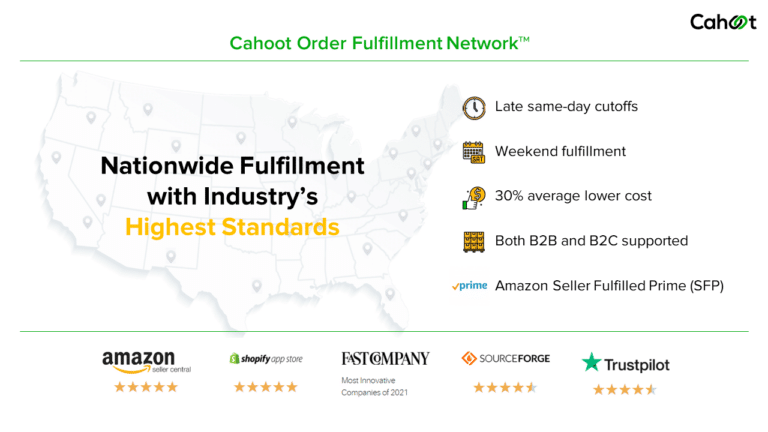
We support warehouse operations, carrier pickups, and delivery on the weekends. We also offer late cut-off times, ensuring that you can increase the proportion of customers whom you service with 1- and 2-day delivery.
Our US-based customer support team is also ready and responsive to any of your questions. We know that eCommerce order fulfillment is complex, and things don’t always go as planned. What’s crucial is ensuring that those issues are addressed quickly, getting your business back on track. With our team, you can count on minimum downtime.
Technology
Traditional 3PL Fulfillment Providers Try to Handle Fulfillment Without Tailormade Tools
Many traditional 3PLs solve just one piece of the problem – the task of order fulfillment itself. Most of them fail to provide customers or their employees with the shipping software technology needed to speed up order fulfillment at scale.
The technology that most traditional 3PLs deploy is not much more advanced than what a micro-shipper fulfilling their orders on their own might be using.
Even if traditional 3PLs deploy technology, it tends to be legacy software, like ShipStation. Such tools require constant human intervention and oversight. For example, for every single customer order that is received, a tool like ShipStation requires staff to compare rates across different fulfillment locations and carrier services, manually identifying the cheapest option to pick.
Such systems mean that an enormous amount of time is wasted every single day by employees simply rate-shopping for shipping labels when they could be engaged in higher-order work.
For other workflows like keeping track of inventory, traditional 3PLs deploy similarly clunky, inflexible software incapable of meeting today’s needs. This runs the risk of accepting customer orders on SKUs that are out of stock, leading to canceled orders and unhappy customers. Unfortunately, your customers aren’t going to blame your 3PL’s poor technology when there are issues with their deliveries – they’re going to point the finger at you.
Peer-To-Peer – Scale Order Fulfillment with Purpose-Built Software
While our peer-to-peer network provides nationwide coverage, our next-generation shipping software supercharges productivity and accelerates order fulfillment.
For every order received, Cahoot’s software can intelligently compare multiple warehouse locations and shipping services, instantly determining the most economical shipping label that meets customer delivery promises.
Our software is designed and purpose-built from the ground up to excel at scale. When your order volumes surge, manually printing shipping labels can be a massive source of inefficiency. With Cahoot, all your shipping labels are ready to print in one click – dramatically speeding up fulfillment and freeing up staff to concentrate on higher-order work.
Our technology comes with other intelligent features – such as optimizing packaging choices for Multi-Line, Multi-Quantity (MLMQ) orders, as well as intelligently keeping track of inventory decrements. Color-coded alerts on our dashboard provide merchants with real-time visibility into dipping inventory levels. This allows for proactive decision making to accelerate sales, rather than scrambling to react too late.
Redundancy and Backup
Traditional 3PL – Highly Vulnerable to Single Point Failures
eCommerce order fulfillment is not an easy thing, and there are potentially many things that can go wrong – such as 3PL delays with receiving your inventory, damages to inventory in transit, misplaced inventory, or carrier errors.
There are also things for which it is difficult to account for – such as unexpected, extreme weather events that disrupt carrier operations.
While you can strategize to minimize or avoid some issues, others are simply out of your control. Unfortunately, this is where a traditional 3PL is highly vulnerable. When you operate from a single location, an outage in that location can be catastrophic. Your entire order fulfillment operations come to a grinding halt, putting your sales on pause. Worse, customer complaints will surge, resulting in lots of negative reviews and refund requests.
Customers today may not be forgiving even of circumstances outside your control, such as weather events – they ask a pertinent question, “Why weren’t you prepared with an alternative strategy?”
One minor issue at your 3PL can quickly snowball into a disaster for your brand reputation and customer loyalty. The only option sellers have is to find fulfillment partners whose solutions come with excellent risk mitigation, ensuring that orders reach customers no matter what.
Peer-To-Peer – Always Lights On For Your Business
A network of warehouses in different locations ensures that you’re inherently much more likely to keep your business operations constantly running smoothly.
You’re de-risked on multiple dimensions – if there’s terrible weather in 1 location, you can still fulfill orders from another warehouse. If there are issues with a carrier over there, you can ship from another location. If there’s an outage there….you get the idea.
This ensures that you’re constantly selling and customers are constantly getting their orders. They may also really appreciate how your business is always ready to serve them, no matter the circumstances. Unexpected, adverse circumstances don’t result in angry customers and negative reviews when working with Peer-to-peer fulfillment networks, they’re just another opportunity to continue selling and keep providing your customers a great experience.
Looking for a New 3PL? Start with this Free RFP Template
Cut weeks off your selection process. Avoid pitfalls. Get the only 3PL RFP checklist built for ecommerce brands, absolutely free.
Get My Free 3PL RFPScalability
Traditional 3PL – Works Initially, But Stumbles at Scale
Going back to our earlier example, let’s say you’re a brand starting out in the Midwest, and you found a great traditional 3PL in Chicago, IL. You’re thrilled because your geographical proximity to them means that you’ll be saving a lot on inbound freight costs (sending your inventory to their warehouse on a truck).
In your first few days, most of your customers are your friends, who spread the word about your brand to their circles. Most of your orders tend to come from the Chicago area and Michigan – things are working well with the traditional 3PL. You can service your customers with fast delivery while using economical ground shipping.
At some point, your brand surges in popularity, and you start receiving orders nationwide – you’re thrilled and can already imagine the cash registers ringing! However, after an initial surge, you soon see very few orders coming in. After doing some investigation, you discover that your 3PL’s inefficiencies are costing you – customers in Southern California are receiving their orders far too slowly. Worst of all, knock-off listings on the Amazon marketplace have seized on your idea, and are now winning against you because they’re offering customers faster shipping. You also see a surge of refund requests, from customers who are unhappy with the time it’s taking for their orders to arrive.
Traditional 3PLs are ill-equipped to deal with spikes in order volume that happen naturally as you scale. These companies don’t become an enabler of your growth; they can be just the opposite – a bottleneck that slows you down.
The problems with traditional 3PLs mount at the worst possible time – once you start seeing orders come in from Southern California, let’s say you identify another fulfillment partner in Los Angeles. Now you have two contracts, each with its own pricing structure. There are 2 different SLAs for order fulfillment and you have to pick which location each of your orders is routed to, all on your own. Managing these two 3PLs can completely consume your bandwidth, overtaking your focus on the activities that actually matter – selling and taking care of your customers.
Other problems emerge as you scale – let’s say you’ve somehow figured things out, and have made DTC fulfillment work with these two traditional 3PLs. As you grow further, you start sending pallets to retailers all over the US, such as Target, Nordstrom, or Macy’s. Suddenly, your 3PL has no space for your containers and struggles to handle B2B fulfillment. Additionally, many of these traditional 3PLs may lack the EDI technology which is a prerequisite to work with many retailers and brands.
Peer-to-Peer – Accelerates Growth By Scaling Alongside You
Let’s imagine you’re the Midwest brand again. This time, you’re working with Cahoot’s peer-to-peer network. When you start out, you ship orders from one of our Midwest fulfillment centers, providing customers with free, fast shipping.
When your brand surges in popularity, things don’t fall apart – you simply add more nodes on the Cahoot network to fulfill orders from. You use our fulfillment centers in Southern California to ensure you deliver a high-quality experience to your customers on the West Coast.
You also work only with 1 vendor, offering you 1 contract. This ensures you can scale nationwide fulfillment, with none of the process management overhead that working with traditional 3PLs brings.
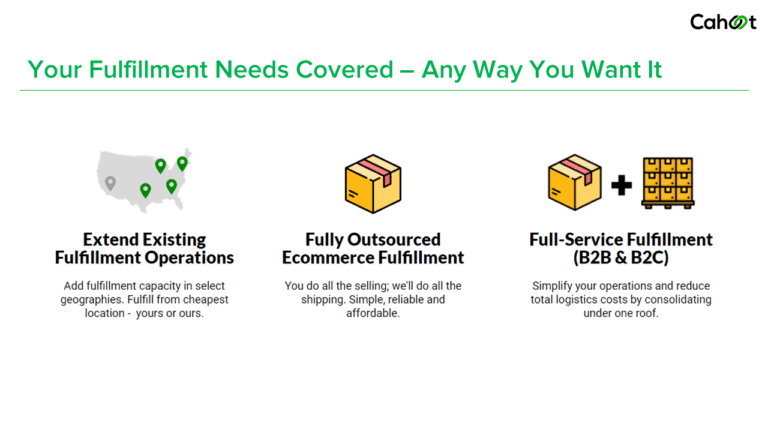
We also have experience and expertise in handling B2B fulfillment, in addition to DTC fulfillment. Whatever the spike in order volume you see, we’ll make sure that you actually celebrate your success. You won’t be spending your time thinking, “Can our fulfillment keep up with all this growth?”
Traditional 3PL – Great for Regional Shipping
Traditional 3PLs do a reasonably good job of servicing the specific parts of the country that they are located in. For example, a traditional 3PL on the West Coast might be great for orders in all states in that part of the country.
Because of the restrictions on the number of locations they have, these 3PLs find offering nationwide coverage at affordable rates extremely difficult.
While these models may work for brands with a strongly regional customer base, the problem is that nearly every seller dreams of scaling nationally and globally at some point – these 3PLs can often become a hindrance when the sellers do decide to start expanding.
Peer-to-Peer – Great For National Programs Like Amazon SFP
Previously, Amazon’s Seller Fulfilled Prime (SFP) program had a regional component – brands could fulfill orders just in their region of the country on their own while still featuring the Prime badge on their product listings on the Amazon marketplace. However, Amazon now expects fast shipping across the entire contiguous U.S. on the program – products across every size category must be delivered in 3-5 days, while approximately 70% of orders on standard-sized products must be delivered in 2 days or less.
Traditional 3PLs will find it nearly impossible to meet this requirement using ground shipping because of their location constraints. Using air shipping is not an option for sellers in most cases because that erodes any cost savings they were hoping to see over FBA.
Analytics and Reporting
Traditional 3PLs – Decisions Made on Instinct
Traditional 3PLs tend to make most decisions using a combination of intuition and guessing. Some of the most crucial pieces of the eCommerce order fulfillment workflow are – Which warehouse to dispatch an order from, and which box to pack the items in?
Most traditional 3PLs do not have the purpose-built technology needed to determine the warehouse each order should be sent from. At best, a rudimentary heuristic based on the customer’s ZIP code might be deployed. The problem is that you could be losing money on every shipment. Until you invest in the right technology, you’ll never actually know the full extent of your losses.
The second crucial factor is the choice of box to use. Traditional 3PLs have a limited number of boxes of the most popular sizes. They randomly throw products into any box that fits. In the best case, an ad-hoc heuristic might be defined to map each SKU to a box, by eyeballing the box and product sizes. This creates problems on multiple dimensions. The first is that the overall cost of packaging materials continued to increase at a pace faster than inflation, while the cost of paper and cardboard increased by as much as 9% in 2024. This means that if you’re selecting larger sized boxes on each order, your costs surge. More crucially, the shipping carriers set their prices in tiers, based on the dimensional weight of items. This means that the wrong choice of box for a lightweight item can tip it over into a higher pricing tier than is actually needed. Sellers can bleed money on both avenues – cost of supplies, and the fees they pay to the shipping carriers. Today, there is also a growing consumer demand for environmentally responsible, sustainable packaging. When items reach environmentally conscious consumers in oversized boxes, it can negatively impact the experience they have with your brand.
Lastly, most traditional 3PLs do not offer enough variety of warehouse locations to actually place your inventory close to where most of your customers live – even in cases where they have multiple warehouse locations, they could still place your products in the wrong fulfillment center!
The only way to eliminate ambiguity and make the optimal selection each time is to ensure decisions are guided by past data and real-time technology automation – unfortunately, most 3PLs do not offer that.
Peer-to-Peer – Decisions Informed by Data
With Cahoot’s Peer-to-peer network, we let data and technology make the most critical decisions.

For order routing, our next-generation software intelligently compares multiple warehouse locations, carriers and shipping services before picking the most optimal location and service that can meet the delivery promise committed to the customer.
We use advanced 3D bin technology to evaluate the fit of items in boxes, ensuring that each SKU goes into the best-sized box. Our software also comes with intelligent automation for Multi-Line, Multi-Quantity (MLMQ) orders, where our system learns from box and SKU dimensions, as well as past packaging choices to optimize box selection.
Lastly, while warehouses on our network are located near major population centers, it still means nothing if we don’t place your inventory in the location closest to where most of your customers live. We go deep and sweat the details to identify geographic trends in your historical orders, ensuring that we set you up to see maximum savings.
Flexibility and Agility
Traditional 3PL – High Switching Costs, Hidden Fees, Painful Migration
Traditional 3PLs often do not operate with flexible, merchant-centric models where you can build from what you have. Like we mentioned earlier, each of them comes with limited geographic coverage of the country, and offers their own pricing contract and SLA.
Let’s say you’re working with a traditional 3PL that gives you coverage on the East Coast. While their services are good, you’re trying to find out if there’s a way for you to expand to the West Coast. Traditional 3PLs do well when they have as much of your inventory tied to their warehouses as possible. You may be hit by high fees on both fronts – the removal fees from the East Coast 3PL, and the inbound fees with the West Coast provider.
Worst of all, once you do manage to migrate your inventory over, you’ll still have to deal with the process management overhead that comes from working with two fulfillment partners.
While this does not sound like an easy process, we’ve put together a step-by-step guide on how to migrate from one fulfillment partner to another.
Peer-to-Peer – Seamless, Painless Migration
A Peer-to-Peer Network is the most merchant-centric, merchant-inclusive platform for Order Fulfillment. Cahoot’s Peer-to-Peer network is not a ‘winner takes all’ arrangement. We’re not only an option for merchants looking for ultrafast eCommerce order fulfillment, but also an option for 3PLs looking to serve their customers better.
When our customers are happy with using their existing 3PL to serve a particular part of the country, say the West Coast, we can flexibly scale nationwide coverage on top of their current setup. They can bring their 3PL to our network, where we provide them with an economical way to cover the East Coast.
In fact, one of the biggest features of the peer-to-peer model is that it can be a way through which traditional 3PLs can overcome their geographical constraints while helping merchants achieve free, fast nationwide shipping.
Integration and Consistency
Traditional 3PL – Extremely Fragmented, Increased Overhead
Many traditional 3PLs were designed for the older, pre-Amazon Prime era of eCommerce when merchants fulfilled orders from just one or two channels. In today’s world of online marketplaces, traditional 3PLs may not support all of the different marketplaces. You may have to work with one 3PL for your Walmart orders, while handling Shopify fulfillment through another. The depth of integration also matters – for example, does the technology these 3PLs use transmit inventory count information back to the sales channel so that you avoid receiving orders on out-of-stock items? Can they transmit tracking information back to the channel? And does your order fulfillment help you meet the unique expectations customers have on each marketplace?
As you work with multiple 3PLs, your ability to offer consistent order fulfillment may be severely compromised. With these providers, handling the basics of order fulfillment becomes challenging. When it comes to exception management on specific orders, the problem worsens.
Let’s imagine you’re working with warehouses from two 3PLs, each with their own SLA – the first has a cutoff time of 1PM, the second 12PM. Suppose an order comes in at 12 30 PM – but there’s been an unexpected issue with the first warehouse. You’re unable to reroute the order to the second warehouse because it’s already past the cutoff time there. The problem stems from the fact that each warehouse has its own SLA and none of them are integrated to each other.
If you’re seeking to expand sales channels or achieve nationwide coverage, the number of such fragmented, siloed warehouse nodes increases exponentially – drowning you and your team in process management. You may need to hire dedicated people to babysit and oversee this operation, which negatively hits your costs.
Peer-to-Peer – Unified, Simple and Consistent Across Every Channel
With a Peer-to-peer fulfillment network, you get custom-built, out-of-the-box integrations for all major marketplaces. We pull all the critical information about orders and their delivery due dates into our system, while pushing back updated inventory and carrier tracking information to the respective channel. This extends to our fulfillment operations – we ensure that you stay compliant with the unique requirements that each marketplace has, such as usage of a particular shipping carrier / service, or branded packing slips.
With Cahoot, you spread your inventory across multiple warehouses, but work with just one partner. This ensures that you can offer a consistent experience on every order. This solid foundation makes exception management much easier to handle. When orders may not make it in time because of issues at one node, we can intelligently reroute it from another location with minimal overhead. We also offer consistent SLAs and every node on the network is tightly connected.
With a Peer-to-peer fulfillment network, the number of warehouses and sales channels increases, but there’s always only minimal process management needed. You and your team will get back more time to focus on growing the business.
Environmental Sustainability
Traditional 3PLs – Excess Packaging Waste and Greenhouse Gas Emissions
Customers today expect brands to be sustainable and environmentally responsible in their operations. A traditional 3PL exacerbates problems for brands across 2 different dimensions, packaging, and emissions.
Traditional 3PLs tend to have a random, haphazard approach to packaging – they have a few boxes of the most popular sizes, and the warehouse staff simply place the item into whichever one might be available on hand.
When the customer receives the order, they might be annoyed that their item was delivered in an overly large box, generating more waste for the environment. For environmentally-conscious shoppers, such experiences can ruin their relationship with the brand, completely turning them off from future purchases.
A bigger problem can arise because of the limited number of warehouse locations. Due to this, they’re forced to use air shipments or keep packages in transit for longer on the road. All this increases emissions released, worsening your brand’s carbon footprint and weakening your sustainability credentials.
Peer-to-Peer – Eliminate Packaging Waste and Slash Emissions
While our network of strategically located warehouses, you’ll nearly never use air shipping (unless customers specifically ask for it). You’ll be able to offer fast and economical ground shipping – which is great for your customers and the environment. But we go a step further and help you cut down packaging waste also.
As we mentioned before, our software’s 3D Bin Technology and its Multi-Line, Multi-Quantity Automation features help ensure you always use only the necessary amount of packaging material.
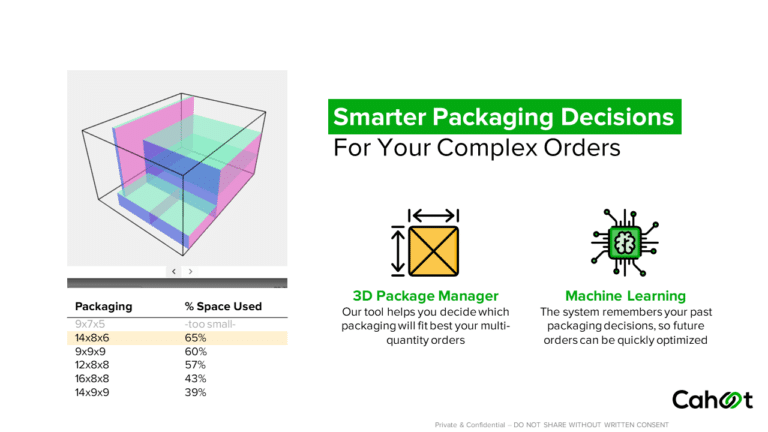
Lastly, environmental sustainability is the core cause that a peer-to-peer network is fighting for – in a world where everyone is using up more resources to build logistics infrastructure for their own private network, we’re aiming to use the Power of Many to build a more sustainable fulfillment network, without compromising on today’s sky-high customer expectations.
Reliability
Traditional 3PL – Fail to Live up to Their Promises
Most people tend to choose a traditional 3PL because they think a company dedicated to logistics and shipping can do a better job than a fellow merchant fulfilling your orders for you.
However, as we’ve discussed in the sections above, we think traditional 3PLs are still operating to serve the old paradigm of eCommerce. While you may feel that you are ‘in safe hands’ initially, the reality may be very different and disappointing.
Most traditional 3PLs may promise a lot, but struggle to deliver even the basics. Where does this disconnect come from? Most sellers are extremely busy and cannot afford to spend endless hours vetting their 3PL’s performance and services. Decisions may be taken with limited information and time – unfortunately, this leads to a lot of unpleasant surprises after the inventory has been received and orders start flowing in.
It’s worth asking – how can merchants rigorously vet their 3PLs to make sure their claims are actually true? With Cahoot, you won’t have to worry about that – because we’ve already taken care of that.
Peer-to-Peer – Only The Best Warehouses Pass Cahoot’s 44 Point Checklist
Some people think that working with a traditional 3PL (with their own warehouse space) is better than operating in a peer-to-peer network. Most people who feel this way share one concern, “How Can I Trust Another Merchant to Deliver My Orders?” A similar concern was shared by many people when Uber first rose to popularity, defeating the cabbies in London and New York’s famous Yellow Taxi. In London, people must spend 3 years training to be accepted as a cab driver. With Uber, nearly anyone could start driving taxis instantly. A similar sort of nervousness was prevalent among people, who asked, “How can we trust getting in a car with a stranger?” Interestingly, the data challenges the popular perception – according to research conducted at NYU, humans trust authentic sharing economy workers more than their neighbors and colleagues (and nearly as much as their families). The keyword in that sentence is authentic. Authenticity is built by high levels of trust and transparency – such as Uber drivers providing their details and a profile picture on the platform.
Similarly, we recognize that building authenticity is crucial. Order fulfillment is a crucial aspect of business operations, and you don’t want to be handing that task over to someone you can’t trust. We foster trust with our sellers by rigorously vetting fulfillment partners. Cahoot has a 44-point checklist that warehouses must pass if they are to become part of our eCommerce order fulfillment network. This ensures that only the best warehouses, with excellent packing practices and order fulfillment standards, make the cut. Cahoot also has zero tolerance for defects and regularly reviews the performance of its fulfillment partners. We think that a warehouse in the Cahoot network has been through more rigorous vetting than the review that the average seller does on a traditional 3PL. This means that there’s a good chance that a Cahoot warehouse is better than the one at your traditional 3PL. With our vetting and audits, you can rest assured that it’s a safe and trustworthy one, too.
Privacy and Security
Traditional 3PLs – Lax Data Security Measures
With traditional 3PLs, your customer information moves across multiple systems without proper safeguards. They might request for all your order and customer information to be transmitted to whatever technology they are using. If that is different from their shipping software, then your proprietary data enters another system outside your purview.
While you may have signed contracts with the 3PL, your data still rests on multiple systems that they operate, with minimum visibility. Worse, you are entirely reliant on their information security practices, which may be minimal or even non-existent.
In the era of Europe’s General Data Protection Regulation (GDPR) and the California Consumer Privacy Act (CCPA), no company can afford a data breach. Under a regulatory framework like GDPR, customers have the right to request for deletion of their data. If sensitive details like their name, phone number and address are already on systems that your 3PL controls, it increases exposure and risk to your business.
Peer-to-peer – Robust Data Privacy and Governance Measures
While having confidence in the order fulfillment standards of our warehouses is important, another concern sellers might have is, “How can we trust that other merchants will not see or use our customer data?” While Uber built high levels of trust in people, it still could not change the fact that people were indeed getting into a car with a stranger. To safeguard its customers and set their fears at ease, Uber has put in place various safety measures on its app. Some of these include GPS tracking, the ability to transmit location information to emergency services, logs of historical trips as well as the very famous rating system – where both riders and drivers review each other after each ride (a social incentive to behave respectfully).
With Cahoot’s peer-to-peer fulfillment network, you can sit back and relax knowing that every order will be fulfilled on time. However, we do know that another merchant is responsible for fulfilling your order, and take data privacy extremely seriously. We provide a single platform where you get total control and visibility into your data. When our fulfillment partner prints a label to ship your order, they see the customer’s first name, but only the initial of their surname. Only the absolute essential information needed for order fulfillment is shared with the fulfillment partner, while all other product / brand / customer information remains with the seller.
Scale Faster with the World’s First Peer-to-Peer Fulfillment Network
Tap into a nationwide network of high-performance partner warehouses — expand capacity, cut shipping costs, and reach customers 1–2 days faster.
Explore Fulfillment NetworkCommunity
Traditional 3PL – You Work With a Vendor
Working with a traditional 3PL is often nothing more than a transaction – you pay them a lot of money, and they perform the task of order fulfillment for you. While getting your orders out to customers is vital, there’s often little differentiated value addition that you get from the engagement.
Peer-to-Peer – Work With a Partner Reduce Costs and Generate Revenue
With Cahoot’s peer-to-peer network, you can have ultrafast eCommerce order fulfillment by partnering with us. But it doesn’t have to end there. If you have excess capacity in your own warehouse, you can actually double up as a Fulfillment Partner on the network to monetize that and bring in additional revenue. Order Fulfillment is a growth driver, not a cost center – with us, those words definitely ring true. This is similar to Uber drivers in their home city becoming riders when they’re traveling!
Summary
While traditional 3PL companies are useful for the things they do well, they have limitations that can put pressure on sellers trying to succeed in the rapidly changing environment of modern ecommerce. For sellers trying to achieve Prime delivery standards without using FBA, or those that simply require nationwide reach for their fast delivery options, a traditional 3PL on its own is not sufficient.
Cahoot’s innovative fulfillment network combines the benefits of a traditional 3PL, but adapted to the needs of a modern online merchant. Ambitious sellers can no longer afford to limit their fast delivery options to certain regions, and they must submit numerous fees and conditions to get the reach.
Whatever your needs, Cahoot can deliver differentiated value to your business. Reach out to us today to get started!

Turn Returns Into New Revenue

Related Blog Posts
October 2023 Seller Fulfilled Prime Guidelines – What’s New, What’s Changed, What’s Important?
In this article
 19 minutes
19 minutes
- No time to read? No problem! Watch this quick video summary instead.
- Program Requirements and Criteria
- Previous Expectations
- New Expectations
- Previous Expectations
- New Expectations
- No More Protection Through Buy Shipping Usage Available
- Previous Expectations
- New Expectations
- More flexibility in picking carriers and services
- Previous Expectations
- New Expectations
- Less Hassle for Merchants in Meeting This Metric
- Previous Expectations
- New Expectations
- Prime Badge Available Nationwide For all SKUs, but with the Caveat of Higher Shipping Fees
- Previous Expectations
- New Expectations
- Delivery Speed Expectations Increase Across Every SKU
- Previous Expectations
- New Expectations
- Time to Enrollment Shortens for Some Sellers, While Others May No Longer Be Eligible
- Previous Expectations
- New Expectations
- Amazon Gives Sellers More Chances, but the Road Back is Extremely Tough
- Previous Expectations
- New Expectations
- Return Costs Rise for Sellers - Even When the Onus is on the Buyer
Watch On-Demand Webinar: Amazon SFP – How To Sell and Win in 2023
On August 8, 2023, Amazon announced a wide range of changes to the criteria it expects sellers to meet on its Seller Fulfilled Prime program. The company introduced new requirements, while updating its expectations from merchants across other metrics. These include on-time delivery, valid tracking, nationwide delivery, delivery speed, free returns and program fees. Amazon has also removed the use of the On-Time Shipment metric and no longer requires the use of its Buy Shipping services.
No time to read? No problem! Watch this quick video summary instead.
In this article, we breakdown each criteria – explaining the old requirements and the new ones that will go into effect on October 1, 2023. We also explain the impact we expect sellers to face from each of these changes.
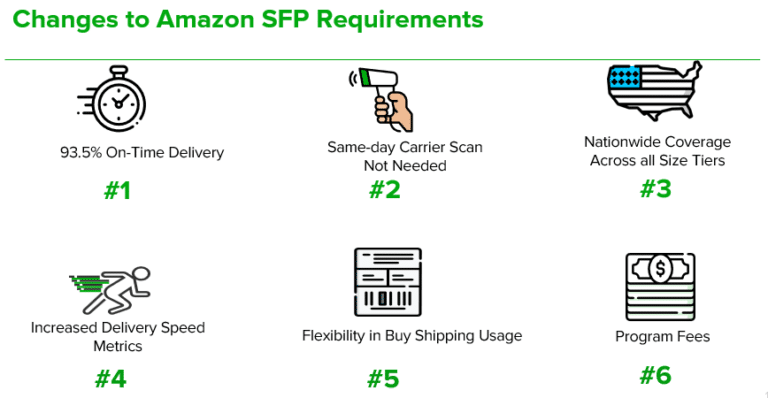
Program Requirements and Criteria
On-Time Shipment (OTS)
The On-Time Shipment Rate is defined by Amazon as the number of units that shipped on or before the Promised Ship Date / Total No. of Shipped SFP Units.
Amazon tracks this metric based on when the carrier scan occurs.
|
Old SFP Requirements
|
New SFP Requirements
|
Impact on Sellers
|
|---|---|---|
|
> 99% OTS rate expected.
|
Amazon is no longer going to track this metric on Seller Fulfilled Prime. The company claims that it is doing this to provide greater flexibility of shipping services and carrier options.
|
Positive (but only if you have the right technology in place!).
|
Previous Expectations
If an order is received before the cut-off time Mon-Fri and Sat/Sun (whichever the seller prefers to enable), carrier scan must occur the same day.
A carrier scan must occur the next day if an order is received after the cut-off time.
This is the most important metric in the current Seller Fulfilled Prime requirements.
New Expectations
Sellers will no longer be judged on this metric.
You don’t have to ship the same day if shipping tomorrow is optimal
Under the current Seller Fulfilled Prime guidelines, Amazon requires sellers to ensure a carrier scan is conducted the same day for all orders received before the cut-off time.
There are situations where this rule forces sellers to unnecessarily use expensive air shipping, at the expense of more economical services. It’s best to understand this with an example:
Let’s imagine you’re a seller with 2 warehouse locations – one in Los Angeles and the other in New York. Imagine that you receive an order from a customer in Connecticut at 3PM ET on a Monday:
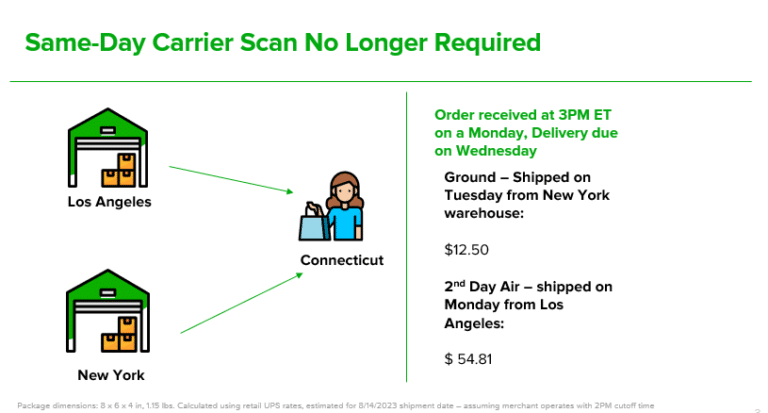
Ideally, you would like to use an economical ground service which can reach the customer in time by fulfilling the order from your New York warehouse. However, because it is past the cutoff time in New York, but before the cutoff time in Los Angeles, Amazon will expect a carrier scan that same day. The only way for you to ship from Los Angeles and deliver to the customer by the promised date is through an expensive air shipping service.
However, with carrier scans no longer required on the same day, you can now choose to ship the next day from your New York warehouse through a service like UPS ground – which is 3.5X cheaper than the air service. Such cost savings can only be achieved, however, if you have the right technology in place. Your shipping software needs to intelligently compare warehouse locations, carriers and shipping services to determine the most economical option to use, which still satisfies the customer expectation.
Slash Your Fulfillment Costs by Up to 30%
Cut shipping expenses by 30% and boost profit with Cahoot's AI-optimized fulfillment services and modern tech —no overheads and no humans required!
I'm Interested in Saving Time and MoneyOn-Time Delivery (OTD)
The On-Time Delivery Rate is defined as Number of Units delivered on or before the Promise Date (which the customer sees at the time of checkout) / Total No. of SFP Units Shipped.
Amazon tracks this metric based on 2 parameters – the delivery date committed to the customer when they checkout, and when the package is actually delivered at their address.
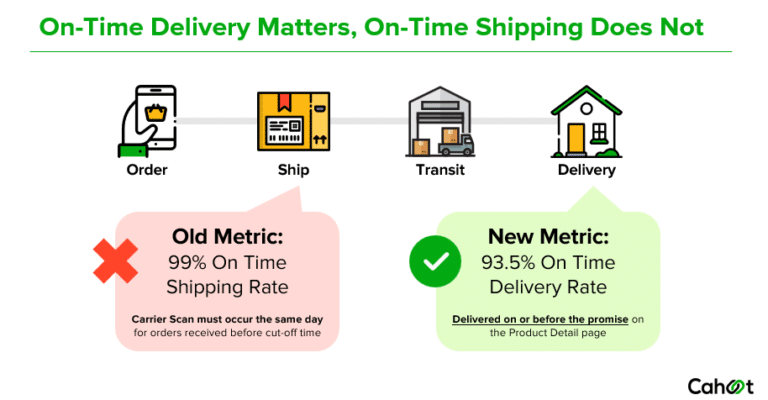
Previous Expectations
Under the old program, Amazon heavily pushed the use of its Buy Shipping Service. Amazon might also believe that only the services on Buy Shipping are capable of meeting the delivery promises made to customers.
Therefore, it was only in cases when labels were bought off of Buy Shipping that sellers were held to the high bar of 97% on-time delivery.
New Expectations
This becomes the most important metric under the new Seller Fulfilled Prime requirements.
Amazon is also going to minimize the provision of “Promise Extensions” (in some cases, the customer is shown a later delivery date because Amazon factors in buffer time due to logistical challenges at the seller’s end).
They encourage sellers to begin by looking at their On-Time Delivery Rate for orders without Promise Extensions (to get a sense of their ‘true’ order fulfillment levels).
No More Protection Through Buy Shipping Usage Available
While the 93.5% on-time expectation is a reduced one, which is more favorable for sellers (they don’t have to be perfect every time), this metric could still work against them. The major reason for this is that sellers now lose the protection that the previous program afforded – so long as they bought the label on Amazon Buy Shipping, and performed the carrier scan in time, they could not be held accountable for any delays in order delivery due to carrier issues. Now, it no longer matters whether the label was bought through Buy Shipping or if a carrier scan occurred in time – sellers must meet the 93.5% benchmark. The biggest contributor to making it happen are the shipping carriers. The biggest criteria by which Amazon measures success on the program is now in the hands of a factor that the seller cannot entirely control – the ability of the shipping carriers to execute operations smoothly and without disruption.
Buy Shipping Usage
Amazon Buy Shipping is Amazon’s system through which sellers and merchants can purchase shipping labels to fulfill their orders.
The Buy Shipping Usage % is defined as the Number of Units for which labels were bought with Buy Shipping / Total No. of SFP Units Shipped
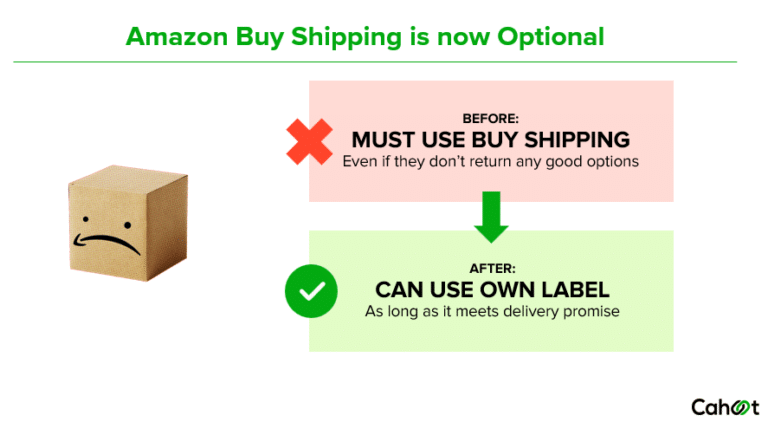
|
Old SFP Requirements
|
New SFP Requirements
|
Impact on Sellers
|
|---|---|---|
|
>99% Buy Shipping usage
|
No longer tracked
|
Positive
|
Previous Expectations
Buy Shipping usage is extremely important. Sellers must print nearly every label on Buy Shipping. Complying with program requirements boiled down to printing labels on Buy Shipping, and then ensuring carrier scans occurred on the same day.
New Expectations
Sellers will not be judged any longer by this metric – this is the biggest step Amazon claims it is taking to provide sellers and merchants “greater flexibility of shipping services and carriers”.
In return for being able to pick services off of Buy Shipping, a timely carrier scan will not suffice – the orders need to actually reach the customer within the Promised Delivery Date >93.5% of the time.
More flexibility in picking carriers and services
Amazon Buy Shipping has one major issue that numerous sellers have reported anecdotally. The platform does not do a good job of estimating the delivery speeds of USPS services. Buy Shipping sometimes excludes USPS services that are actually capable of meeting the delivery date, forcing the seller to pick a more expensive shipping label that it does believe is capable of reaching the customer in time. Buy Shipping also occasionally runs into errors, where it does not return a particular carrier for no particular reason. In all these cases, merchants are forced to buy labels off Buy Shipping, which reduces their usage less than the 99% bar.
With this requirement gone, sellers are now free to pick the ‘truly’ cheapest service. However, you can see the benefits of this only if you have an intelligent multi-carrier shipping software in place that rate-shops multiple carriers and shipping services to identify the truly cheapest label on each order.
Valid Tracking Rate (VTR)
Amazon provides its customers tracking numbers for them to be able to see where their order is at.
An order has valid tracking if it receives a first carrier scan (the scan that is performed by the carrier to indicate that the order is in transit).
Amazon defines the Valid Tracking Rate as Number of Prime packages with a Valid Tracking ID / Number of Prime packages for which shipment has been confirmed.
|
Old SFP Requirements
|
New SFP Requirements
|
Impact on Sellers
|
|---|---|---|
|
Not tracked currently
|
>99% – Amazon requires that the scan be made by an Amazon – integrated carrier.
|
Neutral
|
Previous Expectations
Sellers were not assessed on this metric.
New Expectations
Sellers are responsible for updating shipping carrier, shipping service and tracking number information on Amazon for each order, to enable customers to track the status of their packages.
Less Hassle for Merchants in Meeting This Metric
Amazon expects each package to have at least one carrier scan. This scan must occur before the customer receives their order, so that they can use the tracking number to see where their order is on Amazon. The fact that the carrier scan does not have to occur the same day is a positive for sellers. Many sellers have reported issues with carrier operations on the weekends – their packages are picked up, but no scans are actually conducted on a Saturday. Under the current program, this leads to violations of the OTS metric.
Under the new program, sellers should not face too many hurdles with getting packages scanned once before they reach customers.
Nationwide Delivery Coverage
This refers to the ability for products to be made available with fast shipping across the contiguous United States (the lower 48 states).
This expectation is based on the size tier that the item falls into (Standard Sized / Oversized / Extra Large).
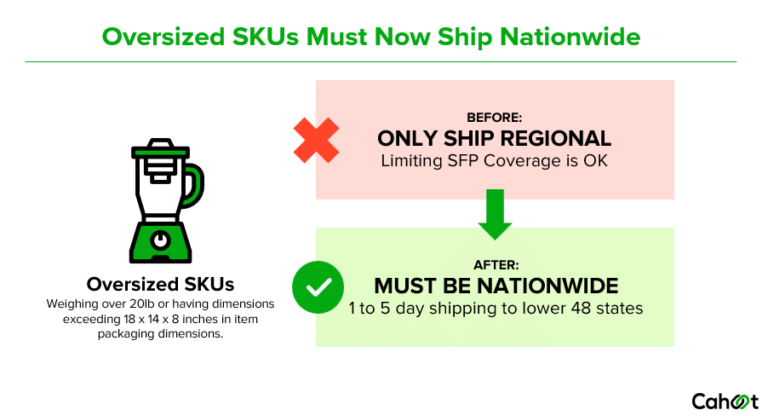
|
Old SFP Requirements
|
New SFP Requirements
|
Impact on Sellers
|
|---|---|---|
|
Only for Standard-sized Products
|
Expected for every SFP SKU, across all size tiers
|
Has Positives and Negatives
|
Previous Expectations
Standard-sized products must be made available within the entire contiguous U.S. on fast shipping.
Oversized items can be serviced within specific regions (also known as Regional SFP) – nationwide fast shipping is not required for them.
New Expectations
Products across all 3 of Amazon’s size tiers – Standard Sized, Oversized and Extra Large – must be made available in the contiguous U.S. on fast shipping.
Any product (regardless of size tier) that is configured with a Prime shipping template has a minimum delivery speed of 3-5 calendar days – sellers cannot edit this.
Looking for a New 3PL? Start with this Free RFP Template
Cut weeks off your selection process. Avoid pitfalls. Get the only 3PL RFP checklist built for ecommerce brands, absolutely free.
Get My Free 3PL RFPPrime Badge Available Nationwide For all SKUs, but with the Caveat of Higher Shipping Fees
Amazon is now willing to provide sellers the Prime badge nationwide on oversized and extra large SKUs, whereas previously it was restricted to just the specific regional part of the country the seller operated from. The metrics for 1- and 2-day delivery are not yet extremely high. This is on the whole a positive for sellers because the Prime badge boosts search rank, conversion and sales on these SKUs.
The negative is that the minimum delivery speed across every size tier is 3-5 days. This is a calendar-day based metric, which includes Sundays and Holidays. Therefore, it may not be possible to always use discount services capable of meeting the delivery timeline, such as USPS Priority Mail, FedEx Home or UPS Ground. In some cases, the seller might still be forced to use expensive air shipping.
Delivery Speed Metrics
Amazon tracks this based on the % of Product Detail page views that promise same-, 1- or 2-day delivery to customers.
This percentage will be calculated based on pageviews from customers across the entire contiguous United States, not just those in your defined regions for Same-, 1- or 2-day deliveries.
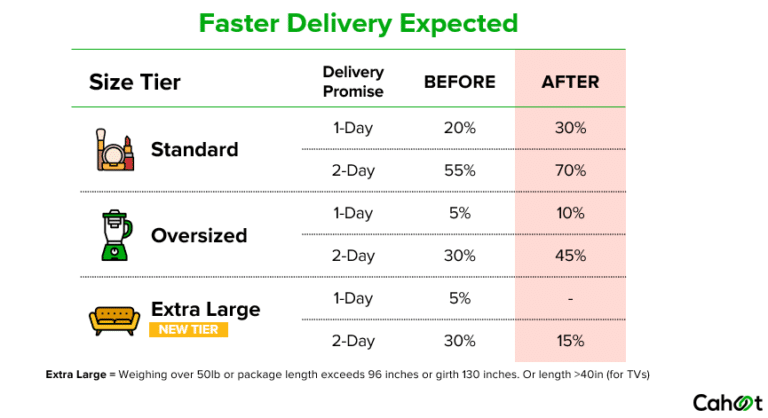
Previous Expectations
Amazon introduced the delivery speed metric as a percentage of product detail pageviews that promise customers same-, 1- or 2-day delivery.
The calculation is based on calendar days, and includes Sundays and holidays.
New Expectations
The delivery speed metrics across all size tiers have increased. They will now be based on pageviews from customers all over the lower 48 states, in addition to those in your defined regions for same-, 1- and 2-day deliveries.
Amazon has said that it does not have targets for Same-Day Deliveries initially.
However, as Amazon focuses on same-day deliveries for its inhouse FBA logistics network, there might be revisions to this in the coming months.
Delivery Speed Expectations Increase Across Every SKU

- This is how delivery promises will be displayed to customers (assuming a cut-off time of 2PM, and that you deliver every order within 1 day after it ships).
- These metrics have always been the most crucial and challenging for sellers to meet. Sometimes, they’ve been unfairly penalized for them also. Let’s say you’re based in New York, and a customer in Connecticut is browsing your product detail page at 6 PM ET. Even though you may be capable of delivering the package to them the next day, Amazon will still show only a 2-day delivery promise.
Achieving a high % of 1- and 2-day delivery pageviews nationwide is not easy, and relies largely on ensuring that your inventory is strategically distributed in a network of USA fulfillment centers so that customers from everywhere see fast shipping promises.
Trial Period
Sellers hoping to be a part of the SFP program must go through a trial period where they can prove to Amazon that they are capable of meeting the rigorous criteria of the program.
During this trial period, when customers shop their products, they will not see the Prime badge on the listings. On successfully completing the trial period and meeting the SFP criteria, Amazon will enable the Prime badge for the listings.
|
Old SFP Requirements
|
New SFP Requirements
|
Impact on Sellers
|
|---|---|---|
|
A short pre-trial process, followed by a 90 day trial where 200 orders have to be shipped, while meting all SFP criteria.
|
A 90 day pre-qualification process, followed by a 30 day trial where 100 orders have to be shipped, while meeting all SFP criteria.
|
Positive for Some, Negative for Others
|
Previous Expectations
Before the trial:
Have a Professional seller account, and activate Premium Shipping. Fulfill 30 Premium orders in 1 month.
During the trial:
Fulfill 200 orders in 90 days. Do so while meeting all requirements of the SFP program.
New Expectations
Products across all 3 of Amazon’s size tiers – Standard Sized, Oversized and Extra Large – must be made available in the contiguous U.S. on fast shipping.
Any product (regardless of size tier) that is configured with a Prime shipping template has a minimum delivery speed of 3-5 calendar days – sellers cannot edit this.
Time to Enrollment Shortens for Some Sellers, While Others May No Longer Be Eligible
Previously, the trial period was longer in length and order volumes – having to fulfill 200 orders in 90 days while meeting the program criteria. Now, if you’ve self-fulfilled 100 packages in the last 90 days (or under, say 60 days) – you can get on the shorter trial of 30 days. The overall time to Seller Fulfilled Prime enrollment is potentially shorter (if a merchant can move past pre-qualification quickly).
However, when comparing 200 packages in 90 days to 100 deliveries in 30 days, sellers are expected to ship nearly 50% more orders per month – this can exclude sellers with small monthly volumes who were previously eligible to participate in the program.
Performance Evaluation
Amazon periodically assesses how its SFP sellers are faring, and to check whether they are meeting the expectations set for them.
|
Old SFP Requirements
|
New SFP Requirements
|
Impact on Sellers
|
|---|---|---|
|
Tracked every 7 days, and every 30 days
|
Tracked every 7 days
|
No change
|
The evaluations that Amazon conducts on sellers continues to occur at the same cadence that it always has – sellers will not face anything new.
Amazon will begin tracking sellers against the new set of metrics beginning October 1, 2023.
Resolving Disputes
Needless to say, order fulfillment is complex and mistakes can occur. While merchants face no penalties for mistakes that FBA makes, sellers on Amazon SFP face severe penalties for issues with orders.
|
Old SFP Requirements
|
New SFP Requirements
|
Impact on Sellers
|
|---|---|---|
|
If a requirement is missed, Amazon will suspend SFP for you and require you to submit a Plan of Action.
|
If a requirement is missed 3 times, you lose SFP eligibility.
|
Positive (if your SFP Fulfillment Partner has responsive support)
|
Previous Expectations
The Plan of Action needs to explain why you slipped up, what specific steps you’re taking to fix the current situation and measures that will be put in place to ensure it does not repeat.
New Expectations
An email will be sent the first time a requirement is missed. The Prime badge will be “paused” the 2nd time you miss the same requirement. If you are sure the issue is fixed, you can restart the Prime badge. If you make it through four weeks without violating the same requirement after you restart the Prime badge, your account will be reset. If you do miss the same requirement the 3rd time, you will lose the Prime badge. If you go through the pre-qualification process, you can start an SFP trial again.
Amazon Gives Sellers More Chances, but the Road Back is Extremely Tough
Under the previous Seller Fulfilled Prime requirements, when Amazon found sellers missing a certain metric, it would suspend them from the program and require submission of a Plan of Action. This was harsh – a single mistake could lead to suspension of the Prime badge. This was exacerbated by the resolution process – it can take a long time for Amazon to get back, and if they deemed the Plan of Action not good enough, they could delay reinstatement on the program.
Now, sellers have 3 strikes per program requirement. Additionally, this gives a chance to sellers to dig into why they missed a metric and work with their fulfillment partner to ensure it does not repeat again. Sellers that have an SFP fulfillment partner with responsive, reliable customer support should not face too much trouble in ironing out their errors and continuing their participation in the program. However, if the 3 strikes do occur, then it is a long, long way back – sellers must begin all over again – right from the pre-qualification process.
Free Returns
When a customer wishes to return a Return-eligible Prime item, the sellers are in most cases required to pay for the cost of the return shipping label, and to provide the customer a full refund. In a small number of cases, the customer might be required to bear the cost of the shipping label – in these cases, a refund is provided after deducting the price of the label.
|
Old SFP Requirements
|
New SFP Requirements
|
Impact on Sellers
|
|---|---|---|
|
Sellers are required to bear the cost of the return shipping labels in all cases, EXCEPT certain Buyer reason codes.
|
For any return eligible item under 50 lb, the Seller must provide free returns – irrespective of the buyer / seller reason code.
|
Negative
|
Previous Expectations
When the return had these Buyer codes, sellers were exempt from bearing the cost of the return label:
- Accidental order
- Better price available
- No longer needed or wanted
- Performance or quality not adequate
- Incompatible or not useful for intended purpose
- Part not compatible with existing system
- Excessive installation or did not install
New Expectations
Sellers must bear the cost of the return shipping label even in the cases of the above-mentioned buyer reason codes.
Return Costs Rise for Sellers – Even When the Onus is on the Buyer
Previously, in certain cases, sellers could provide refunds after deducting the cost of the shipping label. Now, even in cases where the onus may lie on the buyer’s side, the seller must bear the cost of the return shipping label. This is an additional expense that they must bear, which was not the case previously.
Program Fees
|
Old SFP Requirements
|
New SFP Requirements
|
Impact on Sellers
|
|---|---|---|
|
Does not exist
|
No Fee (a charge was originally planned by Amazon and subsequently withdrawn)
|
No Impact
|
Amazon originally announced that they would charge sellers 2% of the unit price for every item shipped via Seller Fulfilled Prime, or a minimum of $0.25.
Amid growing scrutiny from regulators over anti-competitive practises, the company withdrew this fee for concerns over how sellers and officials would perceive such behavior. Amazon withdrew the fee a few days before September 26, 2023 when the Federal Trade Commission and 17 US states sued the company for anti-competitive behavior.
Amazon Resources
We hope you found our breakdown helpful and informative!
To read more about the old requirements that the program wanted sellers to meet, visit this page on Amazon Seller Central: https://sellercentral.amazon.com/help/hub/reference/external/G202072550
To read about the new requirements that Seller Fulfilled Prime will enforce starting October 1, 2023, visit this page on Seller Central:
https://sellercentral.amazon.com/help/hub/reference/external/GXCRLXHNJNPE2DHM
You can also read our guide to selling and winning on Amazon Seller fulfilled Prime to learn everything there is to know about SFP before you start the process in October 2023.

Turn Returns Into New Revenue

Related Blog Posts
Fulfilled By Walmart Meaning: Understanding Walmart Fulfillment Services (WFS) – Pros & Cons | Cahoot
In this article
 11 minutes
11 minutes
- Overview of Walmart Fulfillment Services
- How does Walmart Fulfillment Services work?
- Eligibility and Requirements for WFS
- Costs and Fees for Using WFS
- Benefits of Walmart Fulfillment Services
- Drawbacks of Walmart Fulfillment Services
- Alternatives to Walmart Fulfillment Services
- Frequently Asked Questions
Walmart doesn’t just want to be the biggest brick-and-mortar seller in the world – they know that eCommerce is the way of the future. According to Webretailer.com, Walmart.com is a relatively distant 3rd in online US visitors behind Amazon and eBay, but it’s closing the gap with a huge growth rate. In their efforts to catch up, Walmart is launching programs aimed at ensuring that their delivery experience can match the vaunted standard set by Amazon Prime. Last year, they launched Walmart Fulfillment Services, a new program that enables sellers to store inventory in a Walmart fulfillment center where it is processed and shipped.
In this article, we’ll cover how WFS works, its strengths and weaknesses, and alternative solutions for sellers who want to deliver fast and free on Walmart.com.
Overview of Walmart Fulfillment Services
Walmart Fulfillment Services (WFS) is a program designed to help ecommerce sellers streamline their order fulfillment process. By leveraging Walmart’s extensive network of fulfillment centers, sellers can offer fast and free shipping to their customers, increasing customer satisfaction and loyalty. WFS is a cost-effective solution for ecommerce sellers looking to outsource their fulfillment operations and focus on growing their business.
With WFS, sellers can store their inventory in Walmart’s fulfillment centers, where Walmart takes care of picking, packing, and shipping orders. This not only ensures timely delivery but also enhances the overall customer experience. Additionally, Walmart handles returns and customer service, allowing sellers to concentrate on other aspects of their business. By using WFS, sellers can benefit from Walmart’s logistics expertise and robust infrastructure, making it easier to scale their operations and reach a broader audience.
How does Walmart Fulfillment Services work?
At its core, Walmart Fulfillment Services is a competitive answer to Amazon Prime. The single most important element of competing with Amazon is earning parity on fast and free shipping. Without fast and free shipping, Walmart knows that customers will continue to turn to Amazon. The faster Walmart can grow WFS and get its sellers to use the network, the better its 2-day shipping coverage will be.

Sellers that use Walmart Fulfillment Services for their Walmart listings go through a relatively simple and hands-off process. Once a seller has an account and listings and the seller is approved for Walmart Fulfillment Services, then they send inventory to Walmart fulfillment centers and convert their products to Fulfilled by Walmart listings.
If they don’t have it already, they will then get the Walmart TwoDay badge, boosting impressions and conversion rates. Then, when a customer places an order, Walmart will pick, pack, and ship customer orders – no intervention is needed from the seller. Moreover, Walmart also manages the returns process and provides customer service.
Walmart Fulfillment Centers
Walmart’s fulfillment centers are strategically located across the United States, allowing for fast and efficient shipping to customers. These centers are equipped with state-of-the-art technology and staffed by experienced professionals who handle everything from inventory storage to order packing and shipping. By using Walmart’s fulfillment centers, sellers can take advantage of the company’s expertise in logistics and supply chain management.
Each fulfillment center is designed to optimize the fulfillment process, ensuring that orders are processed quickly and accurately. The advanced technology used in these centers includes automated systems for sorting and packing, which helps to minimize errors and speed up the shipping process. This level of efficiency is crucial for meeting the high expectations of today’s ecommerce customers, who demand fast and reliable delivery.
Looking for a New 3PL? Start with this Free RFP Template
Cut weeks off your selection process. Avoid pitfalls. Get the only 3PL RFP checklist built for ecommerce brands, absolutely free.
Get My Free 3PL RFPMultiple Fulfillment Centers
One of the key benefits of WFS is the ability to use multiple fulfillment centers. This allows sellers to store their inventory in different locations, reducing shipping times and costs. This strategic placement of inventory not only enhances the customer experience but also helps sellers save on shipping costs.
With multiple fulfillment centers, sellers can also increase their product visibility and reach a wider audience. Walmart’s network of fulfillment centers is constantly expanding, providing sellers with even more opportunities to grow their business. As Walmart continues to expand its network of fulfillment centers, sellers can take advantage of new locations to further optimize their fulfillment strategy and improve their market reach.
Eligibility and Requirements for WFS
To be eligible for WFS, sellers must meet certain requirements. These include:
- Being a registered seller on Walmart Marketplace
- Having a valid business tax ID and EIN Verification Letter from the IRS
- Meeting Walmart’s quality and safety standards for products
- Agreeing to Walmart’s terms and conditions for WFS
- Meeting the product size, ship-from location, and category requirements set by Walmart
Sellers must also ensure that their products are compliant with Walmart’s policies and guidelines, including providing accurate and up-to-date product information. By adhering to these requirements, sellers can maintain a high level of trust and reliability with their customers, which is essential for long-term success on the Walmart Marketplace.
Costs and Fees for Using WFS
The costs and fees associated with using WFS vary depending on the seller’s specific needs and requirements. These costs include:
- A monthly storage fee based on the volume of the product and the length of time it is stored
- A fulfillment fee based on the item’s weight and product category
- Additional fees for hazmat items and storage during peak season (October 1 – December 31)
- Return shipping fees
- Removal/disposal fees
- Inventory handling fees for inbound shipments and prep services
- Additional fees for special projects
Sellers can estimate their storage and fulfillment fees using Walmart’s online calculator. It’s essential to note that fees are subject to change, and sellers should regularly review Walmart’s website for updates on fees and pricing.
By understanding the costs and fees associated with WFS, sellers can make informed decisions about their fulfillment operations and optimize their business for success. Properly managing these expenses is crucial for maintaining profitability while taking advantage of the benefits that WFS offers.
Slash Your Fulfillment Costs by Up to 30%
Cut shipping expenses by 30% and boost profit with Cahoot's AI-optimized fulfillment services and modern tech —no overheads and no humans required!
I'm Interested in Saving Time and MoneyBenefits of Walmart Fulfillment Services
A Straightforward Solution For Walmart Orders
Simply put, sellers that use Walmart Fulfillment Services for their Walmart orders have a low-complexity solution. There aren’t complicated integrations to worry about, and management tools are available through the seller’s account with Walmart.
Enables Fast Shipping
Since Amazon introduced its Prime program, 2-day shipping has quickly evolved from a “nice benefit” to a “must have.” In fact, a 2024 Statista report indicated that almost two-thirds of global consumers expect to receive their order within 24 hours. If these expectations aren’t met, your offer will see high cart abandonment as shoppers select it and then realize that it doesn’t come with the delivery service they require.
Walmart Fulfillment Services powers fast and free delivery by automatically enrolling products into the Walmart TwoDay program. Walmart’s studies have shown the program to boost conversion by 30-50% – a massive revenue increase.

Handles Customer Service
Walmart handles all customer inquiries, refunds, and returns for products sold through WFS. In addition to the TwoDay tag, in fact, WFS products get “Free & Easy Returns” and “Fulfilled by Walmart” tags, which further increase visibility and conversion.
WFS saves you a lot of time by handling customer service responsibilities on your behalf. As we’ll see in the next section, though, there’s a drawback to the “Free & Easy Returns” tag.
Drawbacks of Walmart Fulfillment Services
A Point Solution That Doesn’t Work Elsewhere
Just like Amazon FBA and other marketplace solutions, Walmart Fulfillment Services works only for Walmart. You likely know already that the best sellers don’t put all their eggs in one basket – they list across multiple marketplaces and often have their own webstore as well. If you’re one of those top sellers, WFS is only a partial fulfillment solution.
The benefits of Walmart Fulfillment Services as a simple solution for selling on Walmart fade away when you have to manage alternate fulfillment platforms for other selling channels.
Increased Returns
Amazon FBA sellers already are well acquainted with the flipside of easy returns – you may not have to worry about it when a customer calls in a return, but you’ll definitely be worrying about it when you realize how big of a hit your margin is taking. A 5% return rate already sounds like a big issue – but it gets that much worse when you realize that a 5% return rate usually comes out to about a 20% negative effect on net profit.
In its quest to chase Amazon, Walmart has adopted a similar return policy for WFS that enables its customers to process a full refund for almost any reason. Beware – this benefit will boost revenue, but it comes with a big hit to profitability.
Scale Faster with the World’s First Peer-to-Peer Fulfillment Network
Tap into a nationwide network of high-performance partner warehouses — expand capacity, cut shipping costs, and reach customers 1–2 days faster.
Explore Fulfillment NetworkAlternatives to Walmart Fulfillment Services
The most cost-effective way to offer nationwide 1-day and 2-day delivery is to adopt a distributed fulfillment strategy. Of course, Walmart Fulfillment Services will achieve this for you, but it’s far from a complete solution. If you want a more flexible fulfillment approach that can support your multi-channel sales, here are your four best options.
1. Open Multiple Fulfillment Centers: Merchants can take it upon themselves to open multiple US fulfillment centers and control fulfillment. The benefits of total control, though, are offset by challenging market dynamics. Warehouse space has never been more limited or expensive, and hiring frontline fulfillment workers is so competitive that Amazon is paying as much as $22.50 per hour for new employees. On top of that, opening one’s own centers for Walmart fulfillment ties up significant capital and is risky. Pick the wrong location, and you’ll be left footing the bill.
2. Third-Party Logistics Companies (3PLs): Another option is to outsource fulfillment to multiple 3PLs. Since the majority of 3PLs are smaller operations with just a few locations, you’ll have to work with a few to get nationwide 1-day and 2-day coverage. Fulfillment costs vary between 3PLs, so be sure to use something like a 3PL request for proposal (RFP) template to get an apples-to-apples comparison.
3. Flexport: Flexport uses a network of 3PLs to provide nationwide fast and free shipping to Walmart sellers, and if you use it to fulfill your Walmart orders, you’ll automatically qualify for the Walmart TwoDay badge. Like Walmart Fulfillment Services and other 3PLs, Flexport does the heavy lifting of fulfillment for their clients. Also like Walmart Fulfillment Services, though, Flexport is limited in scope. The service focuses on small packages and their fulfillment cost balloons as product size rises. They also avoid the elephant in the room, Amazon, and shy away from doing fulfillment for orders on the largest eCommerce channel. If you use their service, be prepared to add the complexity of other fulfillment solutions as you grow.
4. Peer-to-Peer (P2P) Fulfillment Network: A modern and affordable alternative to working with 3PLs is to use a peer-to-peer e-commerce order fulfillment network. A P2P network is a collective of highly vetted eCommerce retailers who offer up excess warehouse space and resources to provide high-quality Walmart fulfillment to other merchants. As a result, costs are typically lower than what you get with a traditional 3PL fulfillment company, and service levels are higher. With a P2P network, flexible multi-channel fulfillment with nationwide 1-day and 2-day delivery is the norm. The diverse set of merchants ensures that each customer gets a solution customized to their needs, while innovative technology ensures the highest quality fulfillment.
Frequently Asked Questions
What does fulfilled by Walmart mean?
Fulfilled by Walmart (FBW) is a fulfillment service where Walmart handles the storage, picking, packing, and shipping of products on behalf of third-party sellers who list their items on Walmart Marketplace. Similar to Amazon’s FBA (Fulfilled by Amazon), FBW allows sellers to leverage Walmart’s extensive supply chain and logistics network to streamline order fulfillment and improve delivery speed.
How do I enable WFS?
To enable WFS, you must sign up for WFS services in your Walmart marketplace. A US bank account is required for WFS fees. Once signup is complete, you can enable WFS for your Walmart sales channel in the Walmart portal.
How much does WFS charge for fulfillment?
WFS shipping fees are determined by the size and category of the product in question. Apparel, oversize items, hazardous materials, and those with a retail value below $10 per item incur additional fulfillment fees. Use this calculator from Walmart to estimate the cost of fulfilling your products using WFS.

Turn Returns Into New Revenue

Related Blog Posts
How to Grow Sales on Walmart With Two Day and Three Day Delivery
In this article
 18 minutes
18 minutes
- What is TwoDay and ThreeDay Delivery?
- What Benefits do the Two Day and ThreeDay Tags Give?
- How To Qualify for TwoDay and ThreeDay Delivery
- Walmart Seller Performance Standards
- Offering TwoDay Delivery: Walmart Fulfillment Services
- Offering TwoDay Delivery: ShipBob
- Offering TwoDay Delivery: Flexport (Deliverr)
- Offering TwoDay Delivery: Your Own Warehouses
- Offering TwoDay Delivery: Cahoot
- Conclusion
- Frequently Asked Questions
For many sellers in ecommerce, Amazon has long been the platform that they simply could not ignore. However, in recent times, another channel has emerged. Walmart is arguably America’s most well known retailer – the company has a sprawling footprint of around 4,615 physical locations in the US alone. Recent developments, including the rise of Amazon and the Covid-19 pandemic have pushed the Arkansas-based retailer into investing more in ecommerce.
Walmart’s ecommerce accounts for 18% of its total sales volume and expects its ecommerce business to continue to grow significantly, as it has grown over 10% year over year for the last 4 years. The company’s Chief Financial Officer John David Rainey acknowledged that the majority of the company’s profits come from its physical stores. However, he expects ecommerce to continue to grow significantly in the coming years, outpacing Amazon growth. To that end, the company has invested $7.2 billion in supply chain, omnichannel and technology infrastructure. Early results from the company are promising – in the second fiscal quarter of 2024, ecommerce sales grew 24% (compared to 6.4%) for comparable in-store sales. The company also reported that active digital users grew 20% in the quarter. 95% of American consumers visit Walmart stores at least twice a year. While Walmart crossed 150,000 third party sellers on its marketplace as of May 2022, that number pales in comparison to the 1.9 million that Amazon has. However, one thing is certain – Walmart is likely to continue growing investments in ecommerce, and take advantage of the enormous shopper base their physical locations attract. This represents a growing base for ecommerce brands and merchants to sell to.
However, just like Amazon, free and fast shipping is almost a prerequisite for success. On Amazon, customers apply the Prime filter when shopping just to see products that come with fast delivery. In many ways, shipping is no longer a back office operation, it has become central to today’s customer experience. Walmart allows sellers to gain competitive advantages by offering TwoDay and ThreeDay delivery.
In this article, we’ll take a look at what benefits TwoDay and ThreeDay delivery offers on the marketplace, what it takes to earn the TwoDay fast shipping badge, how to ensure you’re compliant with the seller performance standards and some options available to merchants to offer fast Walmart fulfillment.
Slash Your Fulfillment Costs by Up to 30%
Cut shipping expenses by 30% and boost profit with Cahoot's AI-optimized fulfillment services and modern tech —no overheads and no humans required!
I'm Interested in Saving Time and MoneyWhat is TwoDay and ThreeDay Delivery?
As their names suggest, TwoDay and ThreeDay delivery tags are applied to offers on Walmart which feature free delivery to customers in two or three business days.
In a world where customers are constantly comparison shopping across brands, listings and marketplaces, free and fast shipping provides strong competitive advantages. In many cases, customers choose knockoff or imitation products over superior alternatives simply because of faster delivery.
The Delivery Tags are a great way to gain prominence on the marketplace, distinguish yourself from competitors and to build customer lifetime value through repeat purchases.
What Benefits do the Two Day and ThreeDay Tags Give?
The important thing to understand is that the two day and three day delivery options are slightly different from each other in a few, significant ways. In each section, we’ll examine the difference between them and what benefits sellers get from each.
|
Feature |
ThreeDay |
TwoDay |
|---|---|---|
|
Increased conversion |
As high as 30% |
As high as 50% |
|
Buy Box Prominence |
Yes |
Yes |
|
Increased Search Ranking |
No |
Yes |
|
Filter Inclusion |
No |
Yes |
|
Fast Delivery Tag |
No |
Yes |
High Conversion Lift
The single biggest advantage sellers get from offering customers TwoDay or ThreeDay delivery is the increased conversion. In Walmart’s words, these are the conversion lifts that sellers can expect to see with these delivery offerings:
Boosts Search Rank and Discoverability
Many sellers are already familiar with Amazon’s A9 algorithm. For those not aware, the A9 algorithm factors in a variety of criteria to rank listings on search results in the Amazon marketplace. In a similar fashion, Walmart has what it calls a “Listing Quality Score”. The algorithm applies weights to different criteria (such as price and shipping speed) before ranking listings on search results.
Offering two day or three delivery, and earning fast delivery tags go a long way toward improving your Listing Quality Score, improving metrics such as Buy Box win rates and search rankings. Here’s the difference according to Walmart:
The filter inclusion is similar to the filter Prime shoppers apply when browsing the Amazon marketplace just to see Prime eligible listings.
Fast Shipping Badges
On marketplaces like Walmart, customers have almost infinite choice – fast shipping badges are a great way to stand out and quickly become the preferred listing for customers.
Here’s what you get with TwoDay and ThreeDay:
How To Qualify for TwoDay and ThreeDay Delivery
Now that we’ve taken a look at all the benefits that the two badges offer, let’s examine what actually needs to be done to qualify for these options.
ThreeDay Delivery
For ThreeDay Delivery, sellers need to perform no extra work! They can simply configure a shipping template with “Standard” shipping method and then pick a transit time of 3 days.
Sellers can configure their shipping template in the Walmart Seller Center.
TwoDay Delivery
Sellers aiming to achieve two day speeds on their Walmart fulfillment (and earn the fast shipping badge that comes with it) have 3 different options available to them:
- Use Walmart Fulfillment Services
- Work with Walmart’s partners – ShipBob or Flexport
- Ship yourself (using your own warehouses or 3PL).
If you’re choosing to use your own fulfillment, you will need to meet these requirements:
- Have been a seller on Walmart for 90 days or fulfilled at least 100 orders
- Maintain an on-time shipping and delivery rate greater than 95%
- Maintain a valid tracking rate greater than 95%
- Have a cancelation rate lesser than 1.5%
- Offer free returns
Let’s assume you do what it takes and you’re now selling more with your fast delivery tags – great! But as sellers know, it’s crucial to stay on top of the requirements of the marketplace to ensure you retain your fast shipping badges and keep your listings active. Here’s what sellers need to do on Walmart:
Looking for a New 3PL? Start with this Free RFP Template
Cut weeks off your selection process. Avoid pitfalls. Get the only 3PL RFP checklist built for ecommerce brands, absolutely free.
Get My Free 3PL RFPWalmart Seller Performance Standards
As per Walmart’s seller help documentation, these are the requirements that merchants on its platform must adhere to; sellers must ensure their products are delivered on time and in good condition. This includes providing accurate tracking information and maintaining a low rate of order cancellations and returns. Additionally, sellers using freight services must ensure timely delivery to maintain performance standards. Let’s look at these points in detail:
On-Time Delivery Rate
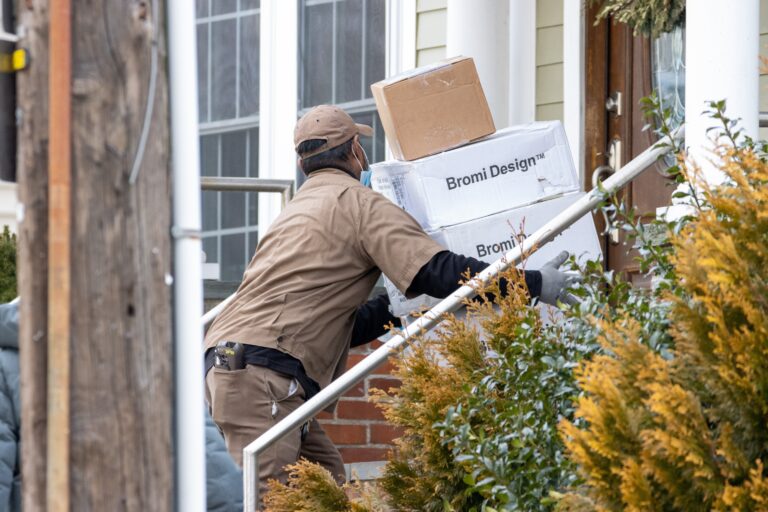
Sellers must maintain an On-Time Delivery Rate greater than or equal to 95%. To give this some perspective, let’s compare this against a program like Seller Fulfilled Prime.
While SFP has more demanding speed metrics (expecting roughly 30% of orders on standard sized SKUs to be delivered within 1 calendar day), Walmart has higher on-time delivery expectations. SFP expects only 93.5%, while Walmart expects 95% on-time delivery.
This means that you need to find partners with order fulfillment networks that have warehouses at multiple strategic locations, so that you can shorten the distance to your customers and make your Walmart fulfillment faster.
The only downside is that this leaves sellers at the mercy of the carriers, such as USPS, UPS and FedEx. Their ability to deliver products accurately and on time becomes important.
Valid Tracking Information
Sellers must maintain a Valid Tracking Rate greater than 99%. This requires strong technology and integrations between your fulfillment platform and Walmart. Whenever you receive orders, your systems must write back tracking information automatically to Walmart.
Make sure that you check your fulfillment partner has solid technology and 2-way integrations (such as Cahoot’s with Walmart) that fetch and push important information.
Refund Rate
Sellers must maintain a refund rate less than 6%. This applies to reasons that the seller is responsible for, such as items being damaged or incorrect items being received.
It is essential that you identify fulfillment partners with checks, balances and procedures to prevent such issues. For example, Cahoot has scan-verification technology to nearly eliminate the possibility of incorrect items being picked and packed. Additionally, you need to ensure that your fulfillment partner has excellent pick-pack and order fulfillment practices to package items well, following all relevant guidelines and procedures. Warehouses on the Cahoot network must pass a 44 point checklist before they can begin fulfilling orders for sellers – ensuring industry leading fulfillment standards.
Cancel Rate
Brands must maintain a seller-initiated cancel rate of less than 2%. Such events can commonly occur when orders are received on items that are actually out-of-stock.
Cahoot has a powerful integration with Walmart that pushes back inventory count information. Additionally, the system also comes with dashboards that provide color-coded alerts about your inventory levels (yellow to indicate it’s time for replenishment, and red to indicate that it needs to be done in a hurry!) This ensures you can minimize stock-outs.
Additionally, if you’re fulfilling from multiple locations, make sure that your software has intelligent exception management capabilities to handle problems at one node. If stock-outs or bad weather occur, you can still keep your promise to customers if your shipping software intelligently reroutes orders to other locations.
Seller Response Rate
Sellers must respond to customer inquiries that they receive within 48 hours, more than 95% of the time. The reason for this is obvious – Walmart is positioning itself as a serious challenger to Amazon, which has built a reputation for stellar customer experience. Walmart expects its sellers to offer customers a similar quality of service.
Offering TwoDay Delivery: Walmart Fulfillment Services
Walmart Fulfillment Services is the retailer’s inhouse logistics network, using which you can make your listings eligible for TwoDay Delivery. Let’s take a look at its pros and cons.
Pros of using WFS
Just like using Fulfillment By Amazon makes your listings eligible for Prime automatically, using WFS earns you TwoDay Delivery. There is no requirement to meet the qualification criteria.
As Walmart invests in growing its ecommerce capabilities, supply chain infrastructure building will be a key focus area. With 31 fulfillment centers dedicated to ecommerce as of June 2022, the company’s warehouse footprint ensures that it is possible to achieve nationwide two day delivery.
According to comparisons between Amazon FBA and Walmart WFS, the two programs are relatively level with each other on fulfillment fees. Sellers already used to working with FBA might see savings on some SKUs with WFS, while others might be cheaper on FBA.
The broad implications for sellers are similar to those with Amazon. For fast moving SKUs with minimum storage times that are small or lightweight, WFS will offer great rates. For big and bulky items, you may be able to find better alternatives offering more competitive rates. The real pain with programs like FBA and WFS is seen on long-tail or slow moving SKUs. When items don’t leave a Walmart Fulfillment center quickly, storage fees can rapidly eat into your margins.
Sellers must choose whether to work with WFS or look for alternative providers based on careful analysis of their specific product catalog.
Cons of using WFS
Possibly the biggest limitation of WFS is that it is restricted to just your Walmart orders. This means you’ll probably need to continue using FBA for Amazon, while you seek out another partner for your Fulfillment By Merchant (FBM) or Seller Fulfilled Prime (SFP) orders. You’ll also have to check if this partner supports other sales channels, such as Shopify (DTC), eBay or Target. Finding such a partner becomes harder if you’re selling to other retailers like Nordstrom or Macy’s, and require B2B replenishments as well.
WFS does not offer competitive pricing for big and bulky items. Additionally, their storage fees make the service impractical for slow-moving or long tail SKUs.
For a seller with a SKU mix that features these types of items, WFS may not make a lot of sense.
You’re already used to sending your inventory to FBA warehouses. That has caused sellers significant headaches with inventory receiving delays and damages in transit. If you use WFS to handle Walmart, you’ll have to repeat all your inbounding processes that you did for FBA – if you sent your items to an Amazon warehouse in California to handle West Coast orders, you’ll have to do it again to a Walmart Fulfillment Center. You’ll have to learn Walmart’s guidelines and processes for receiving inventory and get used to working with another partner.
While Walmart’s warehouse network is smaller compared to Amazon, they also face similar problems – a large number of sellers vying for limited spaces. This means you’ll face peak season surcharges for storage.
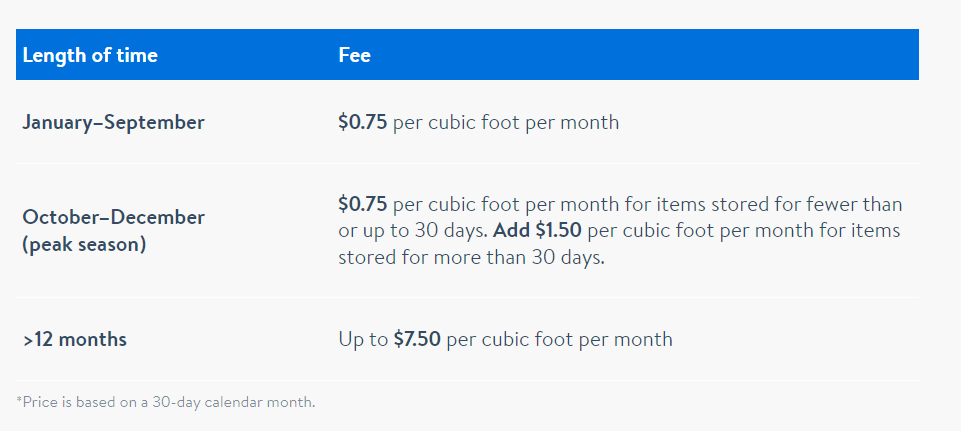
image courtesy: Walmart Fulfillment Services
This illustrates the problem – if you don’t have a SKU that is fast moving, you’re in trouble. This means storage fees triple on SKUs that have been sitting in Walmart Fulfillment Centers for more than just 30 days! For SKUs that have been sitting for more than a year in their warehouses, the rates can be even more expensive.
Scale Faster with the World’s First Peer-to-Peer Fulfillment Network
Tap into a nationwide network of high-performance partner warehouses — expand capacity, cut shipping costs, and reach customers 1–2 days faster.
Explore Fulfillment NetworkOffering TwoDay Delivery: ShipBob
Pros of Using ShipBob
As ShipBob is one of Walmart’s approved partners, brands that use them can instantly activate TwoDay delivery.
ShipBob has a global network of warehouses. This allows them to spread inventory across multiple locations to reach customers within the two day window.
Cons of Using ShipBob
ShipBob operates their own warehouses. While this may provide them control, it also places significant fixed costs and assets on their bottom line. With leasing rates, warehouse worker wages and carrier rate increases all going up, they may have no choice but to pass on the increased costs to their customers.
On the other hand, asset-light, powerful models like Cahoot’s fulfillment network are designed from the ground up to save customers more. In our experience, 9 out of 10 ShipBob customers see savings when they switch to Cahoot.
As this article explains, ShipBob customers have complained about times when they’ve found it difficult to get hold of someone from the company to fix their issues. Walmart does not hold 3PLs accountable for issues with deliveries, it holds you, the merchant, directly responsible.
Offering TwoDay Delivery: Flexport (Deliverr)
Pros of Using Flexport (Deliverr)
As one of Walmart’s official providers, you get instant access to TwoDay delivery.
With over 80 Warehouses, Flexport’s DTC offering (formerly Deliverr) has the scale required to support nationwide 2 day delivery.
Cons of Using Flexport (Deliverr)
Deliverr’s rates are not competitive for big and bulky or oversized items. If a lot of your SKUs are in this category, you might need to evaluate other options.
Since the exit of Dave Clark from Flexport, the company has been facing significant challenges internally. With recent reports that the company plans to lay off as much as 20% of their workforce, prospective customers might be nervous about the ability of the company to keep up its service levels and customer experience.
“The real difference-maker for us with Cahoot was [that Cahoot works] across the board and that regardless of where a consumer is, they can get their product in two days. The Cahoot full-service solution simplifies our operations and upgrades our delivery experience at the same time.”
~ Cali’s Books (switched from Flexport to Cahoot)
Speak to a fulfillment expert
Offering TwoDay Delivery: Your Own Warehouses
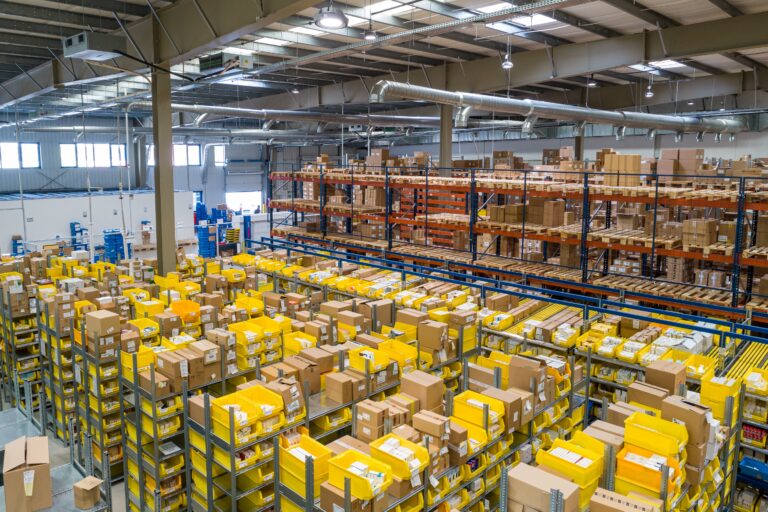
Pros of Using Your Own Warehouses
You make the rules, you play by them! Having your own fulfillment operations frees you from having to rely on anyone else for fulfillment.
If you can manage your fulfillment for WFS, that allows you to scale the same for your other sales channels and online marketplaces. You don’t need to inbound inventory multiple times. It allows you to become leaner and manage your inventory much more efficiently.
Cons of Using Your Own Warehouses
With warehouse lease rates, worker wages and carrier GRIs all on the rise, it has rarely been more difficult to absorb the last-mile costs associated with making deliveries.
A brand aiming to cover the continental US with 2 day shipping requires at least 4 strategically located warehouses (a strategically located warehouse is one that is close to a major population center of the US – such as the Northeast, Southern California, Chicago Midwest region and Texas). This can be a significant drain on your resources. Even for very large brands, the economics are proving hard to justify.
When you bring fulfillment operations in-house, the complexity of running your own logistics can overtake your focus on the activities that actually matter – selling and taking care of your customers.
Running your own fulfillment operations can leave you drowning in busy work and process management.
Offering TwoDay Delivery: Cahoot
Pros of Working with Cahoot
Cahoot has one of the largest warehouse networks in the US. We have 100+ warehouses, rivaling Amazon’s 110 fulfillment centers. Other providers, including Walmart themselves and ShipBob do not have as many warehouses.
Such a huge network offers certain advantages.
The first is that we have warehouse locations that work for nearly any brand. Different brands see orders coming from different regions. Brands selling well-established, commodity-style products might see most of their orders come from the major population centers, such as the Northeast and Southern California. On the other hand, someone selling surfing gear might see most orders come in from Florida and California. Similarly, someone selling skiing and winter sports equipment might see most of their orders come from Colorado or Vermont.
Whatever the geographic spread of your customer base, we’ve got warehouses that can deliver products to your customers in 1 or 2 days using economical ground shipping.
The second is that our vast network allows us to scale to meet the requirements of extremely challenging programs, such as Amazon Seller Fulfilled Prime. What’s challenging for other providers isn’t for us.
While other providers may not have the best rates across all SKU sizes, we have competitive pricing for all types of items – small, fast-moving, big and bulky, long-tail and seasonal.
While the likes of WFS and Flexport may become more expensive for oversized items, Cahoot offers competitive rates across the size spectrum. We also have a good track record of offering ShipBob customers meaningful savings on their current shipping fees.
This ensures that you’ll keep fulfillment costs under control and get back more savings to focus on growing your business.
“We onboarded with Cahoot at the beginning of Q4 with the single goal of reducing our 3PL costs. We have been happy to see considerable savings on SPD costs instantly. The team continue to work with us to ensure we distribute our inventory to the right locations across the US to reduce our SPD label costs. Rather than buying an app or a service, it feels like we have begun a great partnership with the Cahoot team who have a genuine interest in helping our business to succeed.”
~ QUICKPLAY Sport
Speak to a fulfillment expert
With WFS, you’ll have to work with multiple partners to handle your fulfillment across different sales channels. Cahoot is out-of-the-box integrated with all leading online marketplaces and shopping cart platforms. We also support B2B replenishments. You can use Cahoot as a one-stop shop for fulfillment, ensuring that you can run lean on inventory and streamline your operations.
Lastly, working with a partner like Cahoot cuts down the number of relationships you need to manage, freeing your team from process management and busy work. Working with a trusted full-service partner is also better than running your own fulfillment operations. You’ll reclaim time, resources and bandwidth to focus on activities that grow your brand, rather than get caught in the complexity of managing logistics.

When comparing providers like ShipBob, Flexport and Cahoot, the quality of customer support matters. There are many advantages to working with a partner rather than Walmart directly, because of their ability to handle fulfillment on other channels. But the key thing to remember is that Walmart holds brands directly responsible for any issues with shipping. And while fulfillment is crucial to business operations, things don’t always go as planned. That’s why it’s important to quickly get help when you need it. Cahoot’s US based team is always ready to offer assistance when you need it, ensuring minimal downtime for your business.
Cons of Working with Cahoot
cahoot offers the most benefits to merchants with some degree of traction, who are currently shipping at least 250 orders a month (roughly 10 packages a day).
Once merchants cross the initial phase, we can help them scale operations with our powerful network and technology.
Conclusion
Like with Amazon, offering free and fast shipping is critical to succeeding on the Walmart marketplace. Offering TwoDay and ThreeDay delivery has a number of advantages – including improving buy box win rates, rankings in search results and most importantly, conversion lift. Merchants have a number of options available to offer two and three day deliveries, including using Walmart Fulfillment Services, their inhouse logistics, ShipBob, Flexport or Cahoot. It’s important for merchants to identify partners with both a large warehouse network, as well as competitive rates across the size spectrum. It’s also important to look for providers that bring full-service capabilities beyond just the Walmart channel, so that sellers can cut down the number of providers they have to work with to manage their logistics. This has the added benefit of streamlining inventory management. Lastly, sellers should make sure to pick a fulfillment partner that offers reliable, responsive support. After all, you’re accountable to Walmart, not your 3PL!
With the nation’s largest retailer now aggressively investing in ecommerce, it’s a perfect time for all sellers and brands to bring their products to Walmart. The key is doing so in a way that keeps complexity and costs low, while growing sales with free two and three day deliveries on every order.
Frequently Asked Questions
Can I charge customers a shipping fee with TwoDay Shipping?
No, Sellers cannot charge shipping fees while using TwoDay Shipping.
Do I need to apply TwoDay Shipping to all my products?
No. Once approved for TwoDay Shipping, Walmart does not require sellers to apply it on all products.
Does Two Day Shipping include weekends?
No. Weekends and holidays are not included in Walmart TwoDay Shipping.

Turn Returns Into New Revenue

Related Blog Posts
Fulfillment Revamps Cause “Out-of Stocks” for Walmart Shoppers
In this article
Walmart online shoppers are finding it more difficult to order certain items — heavier products like detergent and pet food and bulkier multi-item orders that are expensive to ship — The Wall Street Journal reports.
E-commerce fulfillment is the bane of any online retailer, which is why solving the last mile has emerged as e-commerce’s Holy Grail.
Shipping and fulfillment costs are bedeviling all players, including Amazon, which has arguably set consumer expectations for fast and free shipping. The e-commerce giant’s shipping costs rose 31% year over year in its most recent quarter, after rising more than 30% (and usually more than a third) in the last five quarters, according to its second quarter earnings report.
The company for half a century has staked its own success on fiercely efficient retail distribution, playing hardball with suppliers and honing its supply chain to maximize profits. But it’s a system based on legacy retail, where the customer supplies free labor to cover the last mile: taking items off shelves, bringing them to checkout, loading them into the vehicle and getting it all home.
Walmart has struggled to bring the same level of efficiency to its online sales, though it continues to experiment. Last month, the company revamped a pilot program, in which store employees deliver online orders. And, the company says it will have expanded its prominent in-store pickup towers to 700 stores by year’s end.

Turn Returns Into New Revenue





